Barauli Homestay in Chitwan, Nepal: My Honest Experience
14 min readIf you’re looking to visit Chitwan National Park on safari but would like a culturally rich experience as well, then consider doing a homestay in Barauli where you can stay...
The post Barauli Homestay in Chitwan, Nepal: My Honest Experience appeared first on Bucketlist Bri.
If you’re looking to visit Chitwan National Park on safari but would like a culturally rich experience as well, then consider doing a homestay in Barauli where you can stay with the indigenous Tharu locals.
In this guide, I’ll share all about what it’s really like to stay at the Barauli Community Homestay. Barauli is one of the 36+ homestay communities you can stay with across Nepal through the Community Homestay Network (CHN).
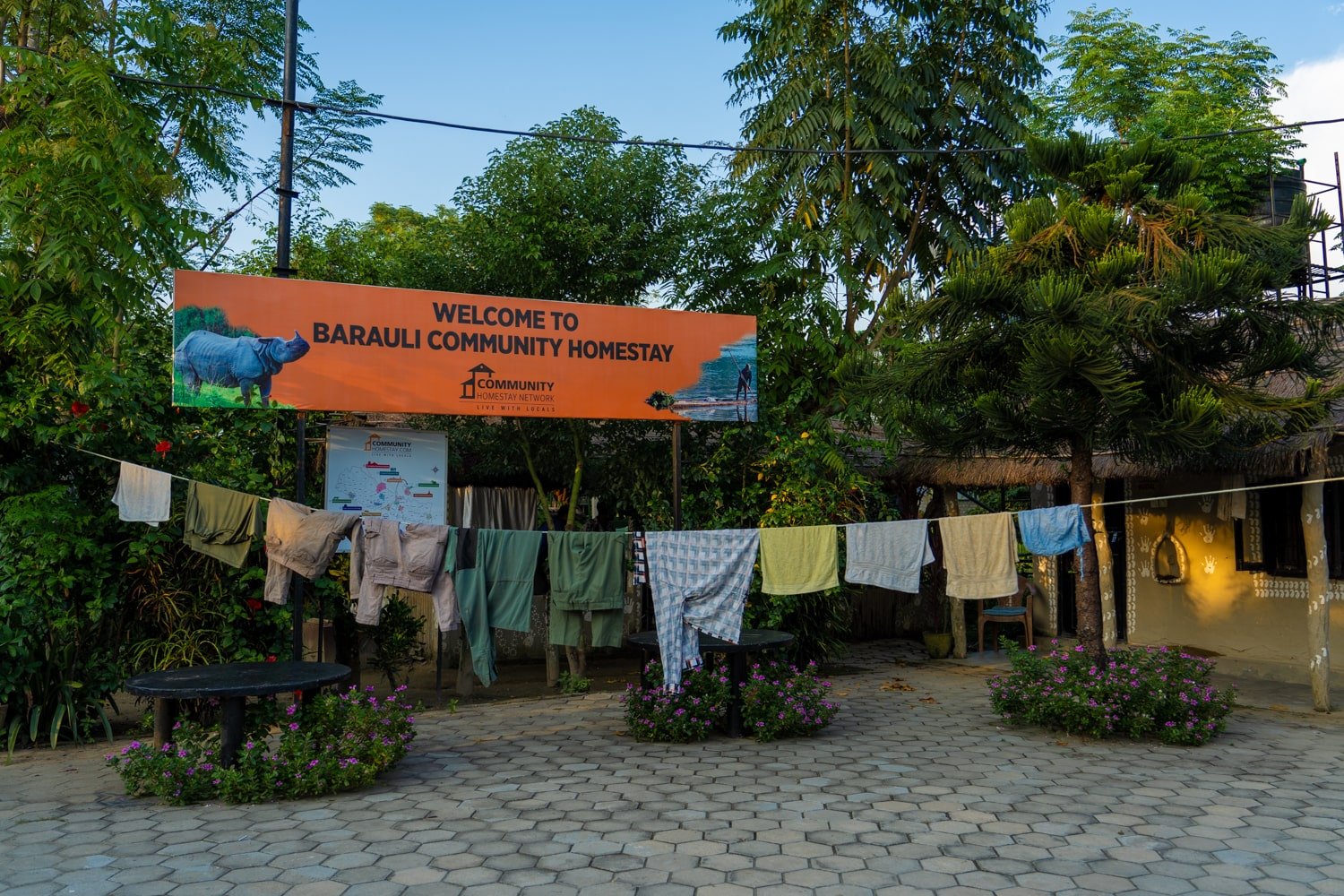
Disclaimer: This post contains affiliate links that may earn me a small commission should you decide to click through and make a valid purchase (at no extra cost to you). Thanks so much for your support!
While living among the Tharu in Barauli, not only will you get to do a jeep safari in Chitwan National Park, but you also have the opportunity to do a cooking class in a local’s home, ride through Barauli village by bike, go net fishing, watch the sunset over the Naranyani River, enjoy a traditional dance show by the Tharu women, and more!
As you can see, there are so many more things to do in Chitwan than watching wildlife.
The best part about doing a homestay in Nepal, and in Chitwan, is engaging with the locals who call this beautiful place home.
Getting to meet and connect with the Tharu—an indigenous group of the Terai region and one of the 125 ethnic groups in Nepal—is such a special experience.
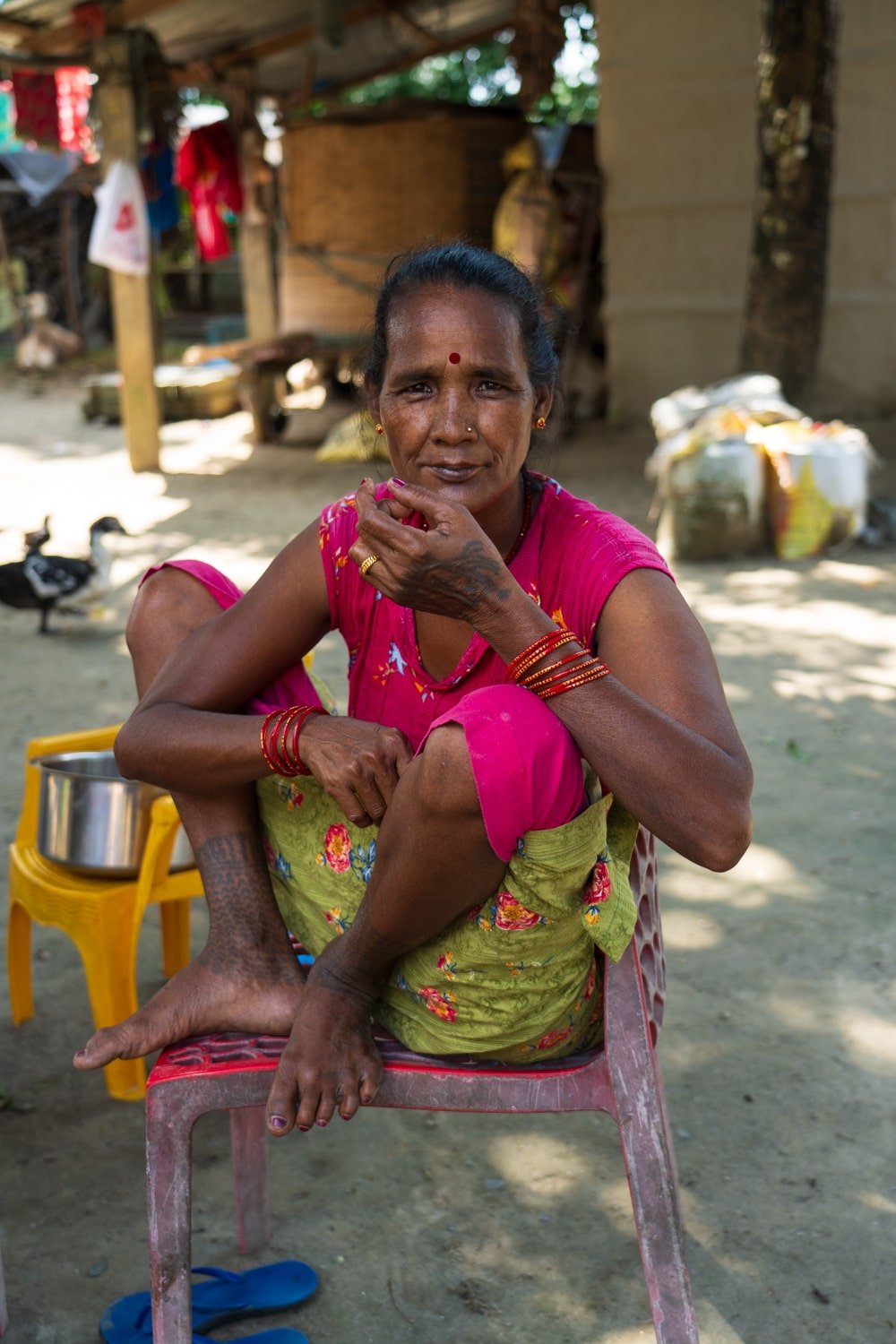
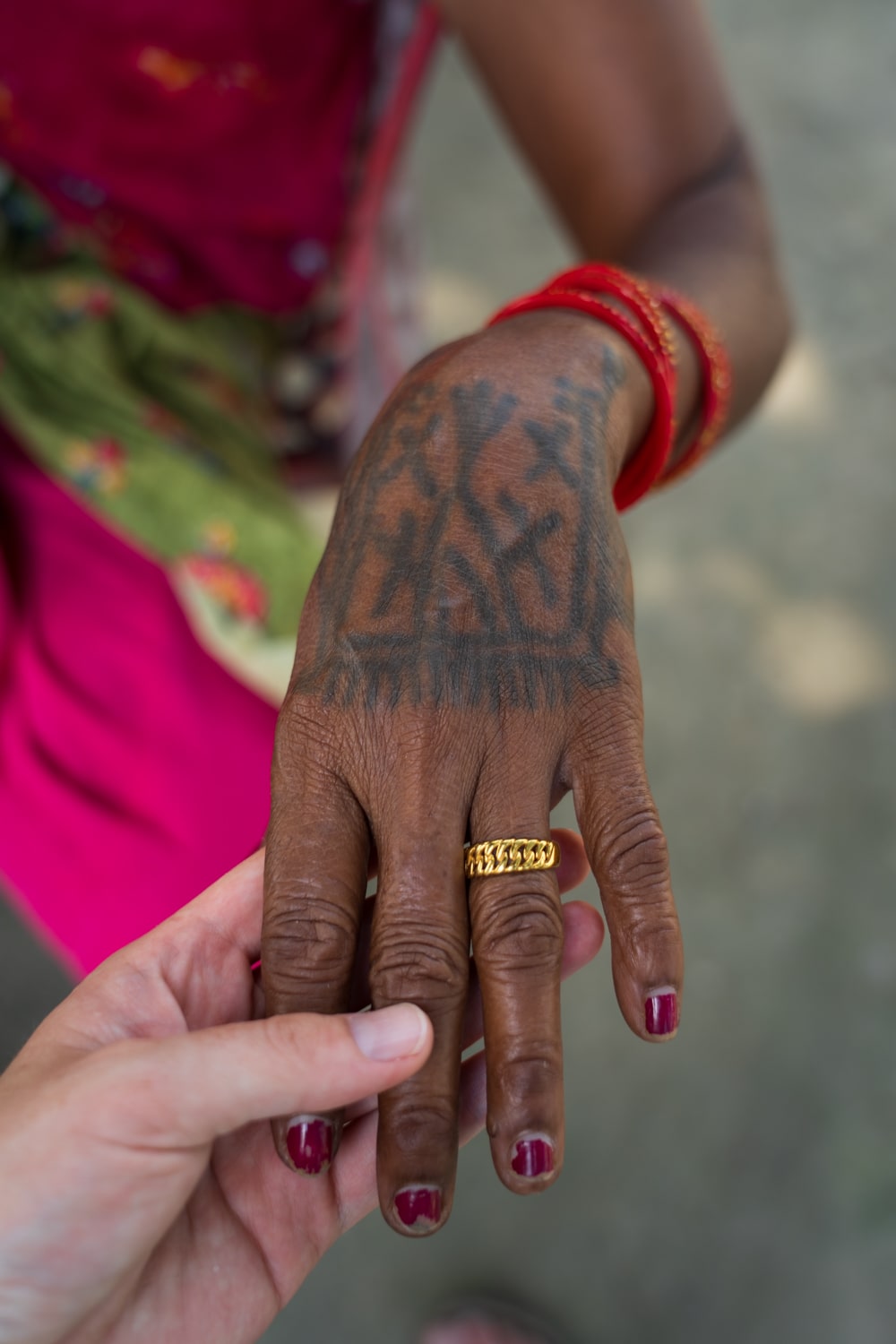
Your stay at Barauli Community Homestay directly supports and empowers the Tharu community, as the homestay employs locals and generates a source of income for many Tharu women and families.
Learn more below about the Barauli homestay in Chitwan and what the experience entails!
show
A Guide to the Barauli Community Homestay in Chitwan
Where Is the Barauli Homestay?
Barauli is a Tharu village located on the western side of Chitwan National Park, just across the Narayani River.
The Barauli Community Homestay is located at the heart of the Barauli village, which is easy to reach by tuk-tuk from Danda town—where your bus will drop you off if you’re coming from Kathmandu.
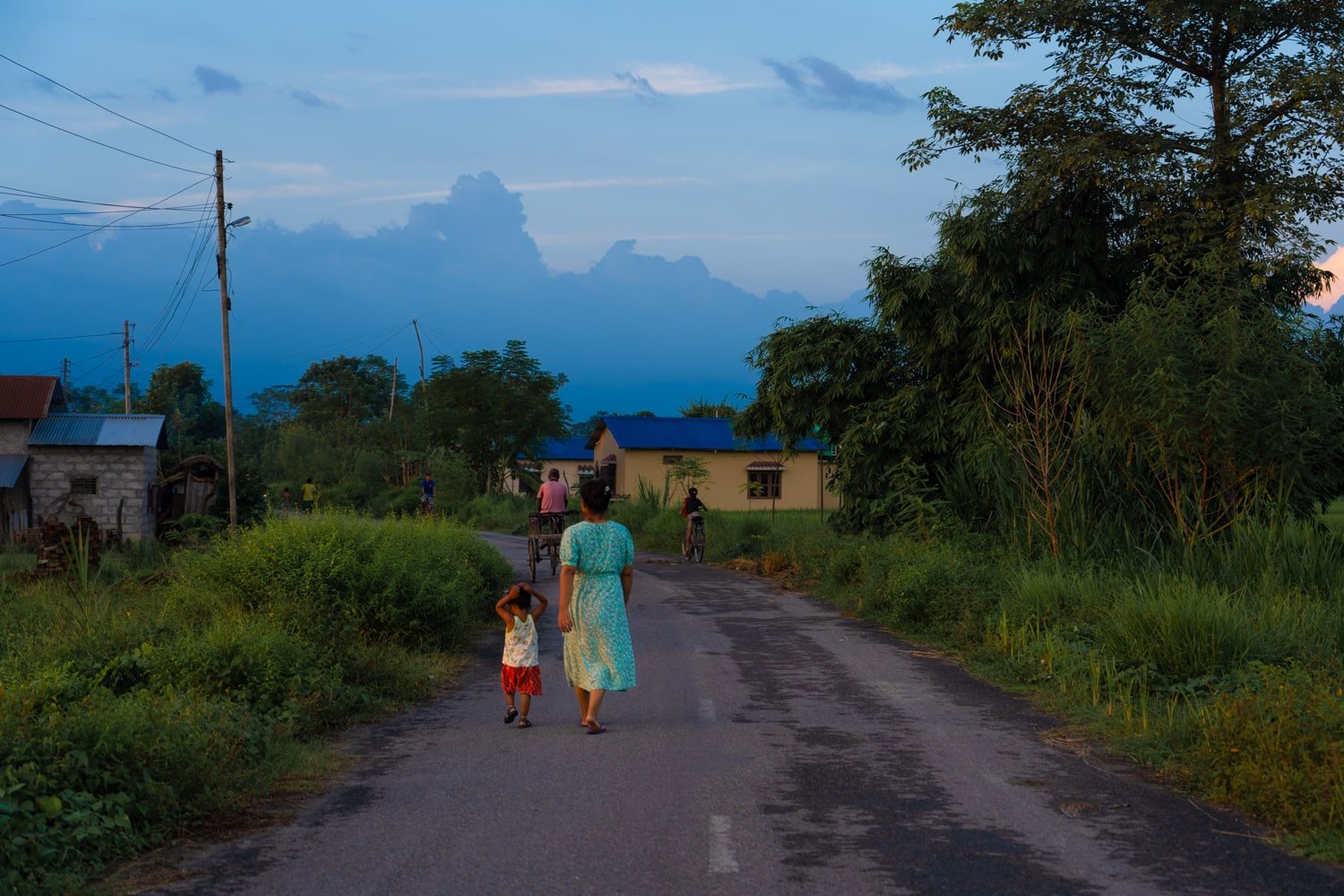
Why Stay in Barauli vs Sauraha in Chitwan?
As you may know, Chitwan is Nepal’s first national park!
Chitwan National Park was established in 1973 in order to protect the rapidly declining and endangered wildlife.
Since its inception, there have been many tourists and foreigners who want to visit Chitwan National Park on a first or second trip to Nepal.
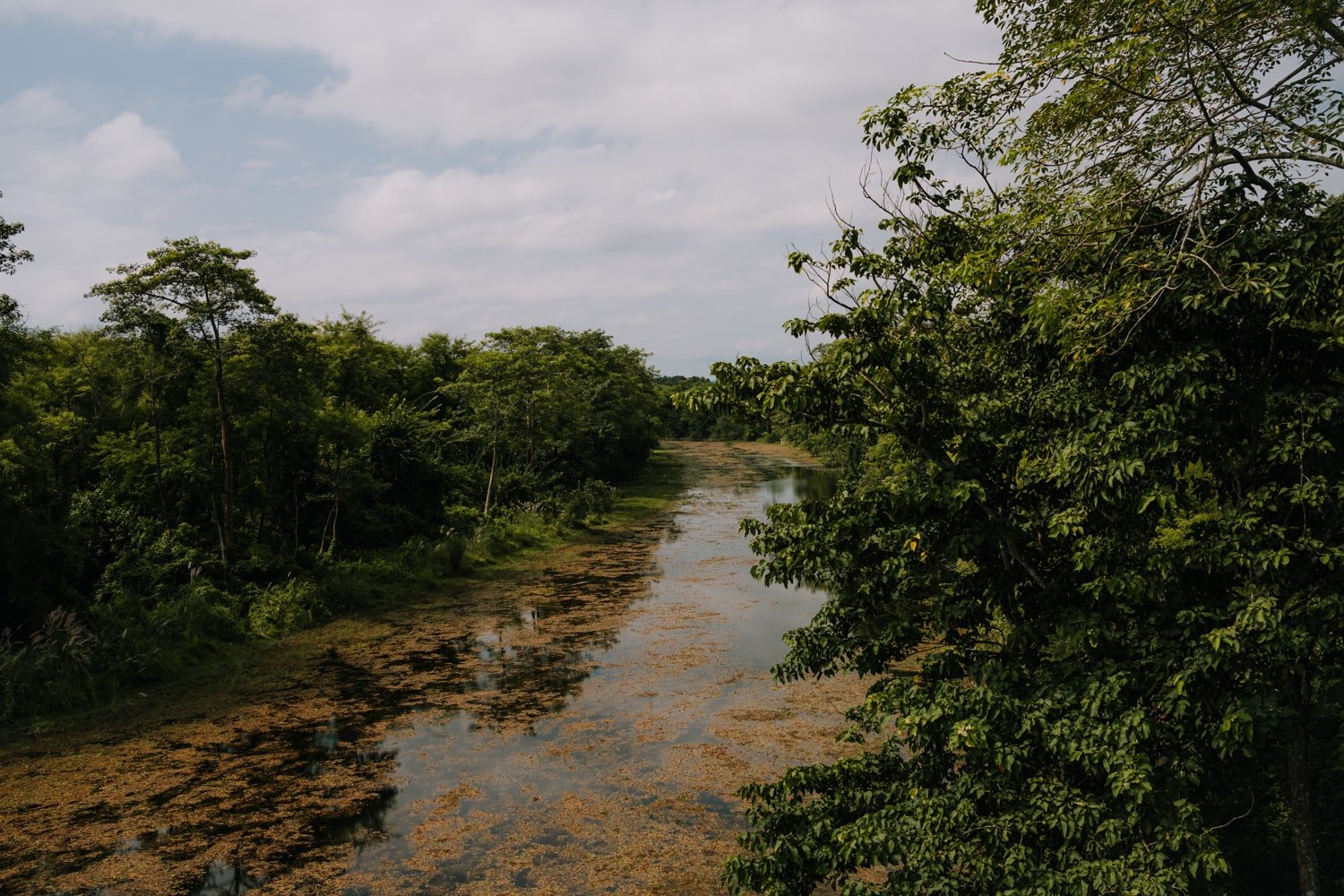
The problem, however, results in over-tourism, which the once-quaint town of Sauraha is now facing as it is the eastern “gateway” to the national park.
That said, the village of Barauli offers a non-crowded, authentic glimpse into the Tharu local life and culture while still being a thrilling jeep ride away from the national park.
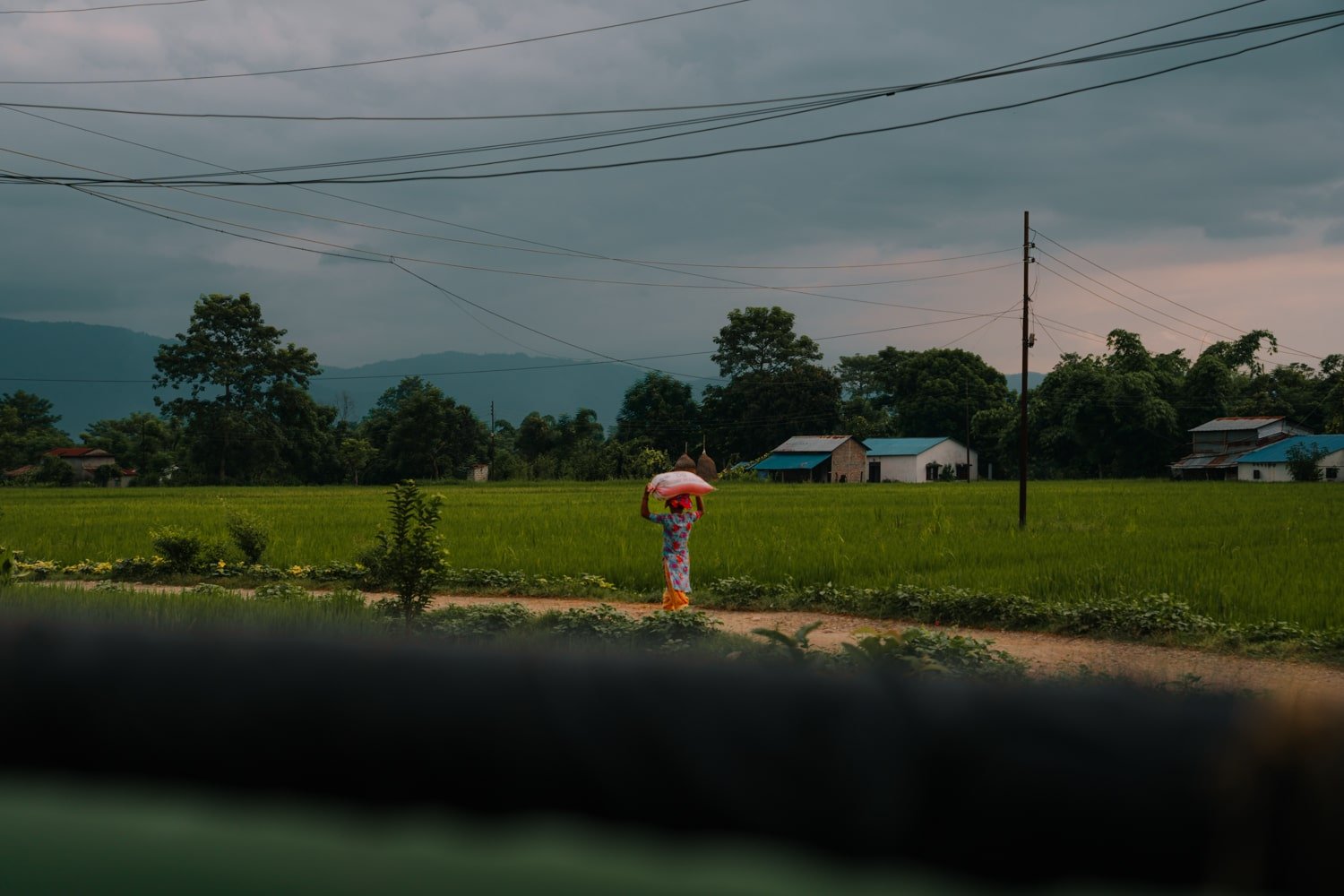
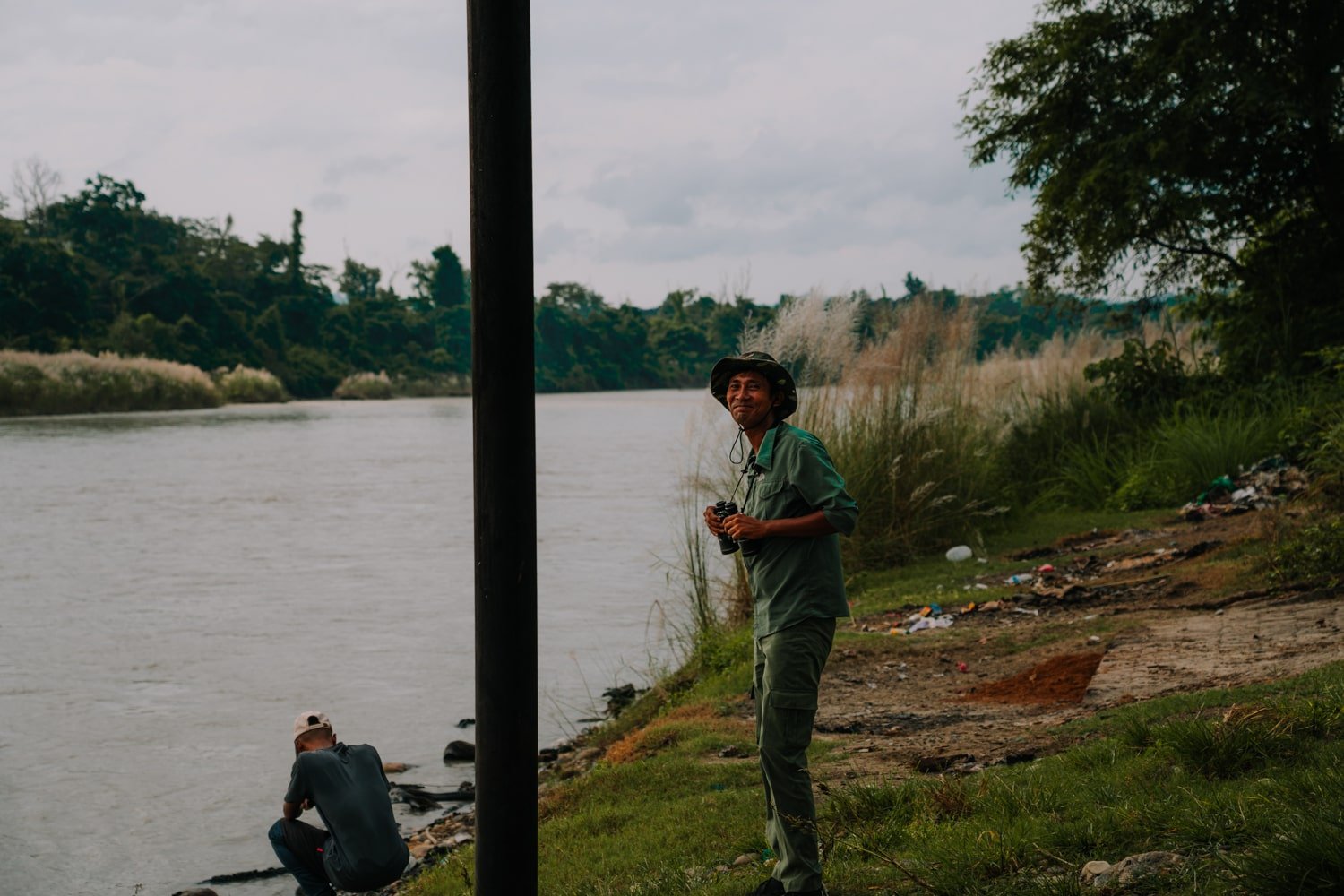
Staying in Barauli Homestay means having a meaningful experience in Chitwan that goes beyond the safaris and resorts.
Not only does your stay do good, but you can feel good about staying at Barauli Homestay as well!
“A major attraction of the Barauli Community Homestay is the fact that you can combine cultural learning with nature and wildlife-focused activities.
Many visitors to the Chitwan National Park are only exposed to nature and wildlife, but by staying at this homestay in Nepal you will meet the people who live around the park, learn about their lifestyles, and witness how nature and culture coexist.“
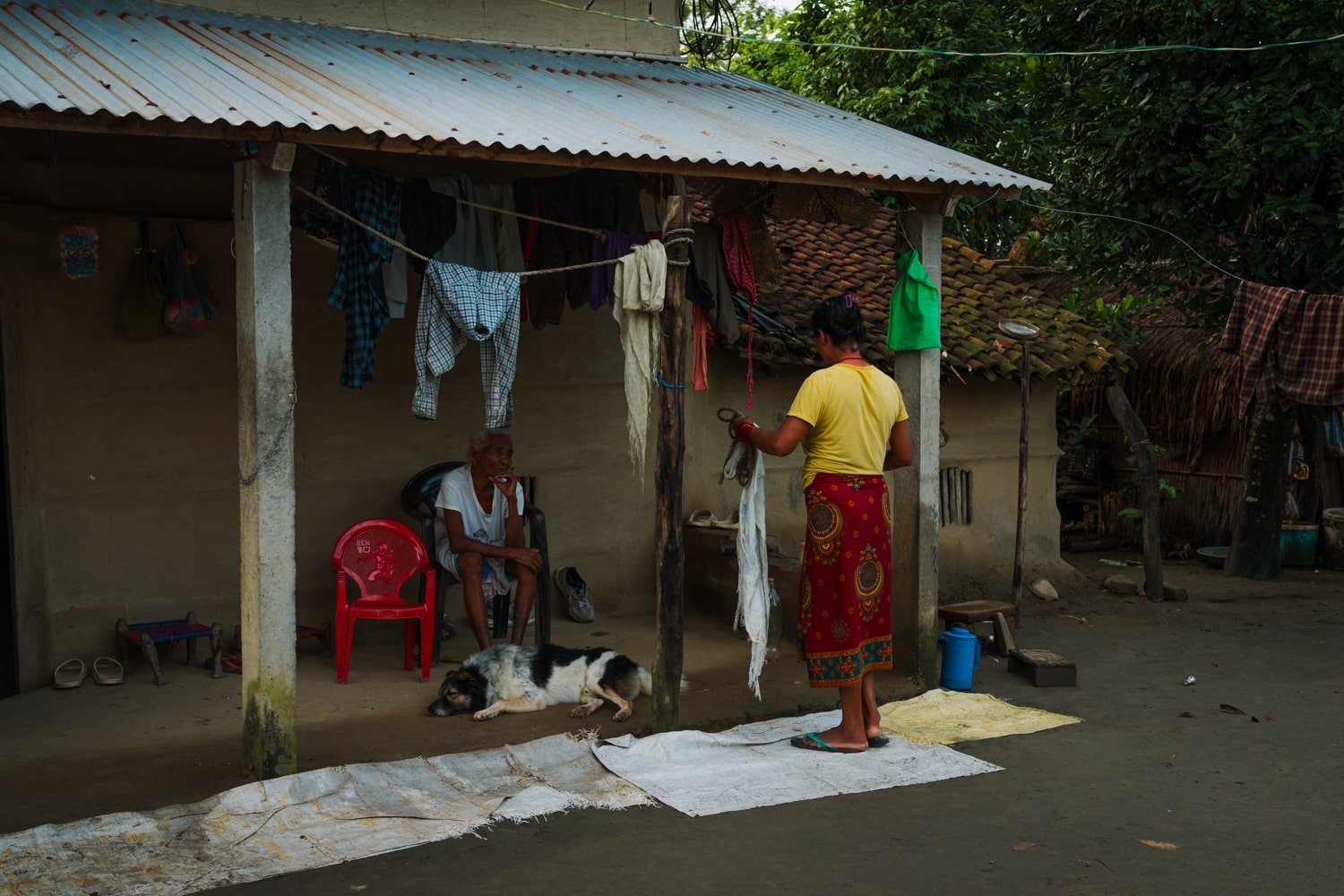
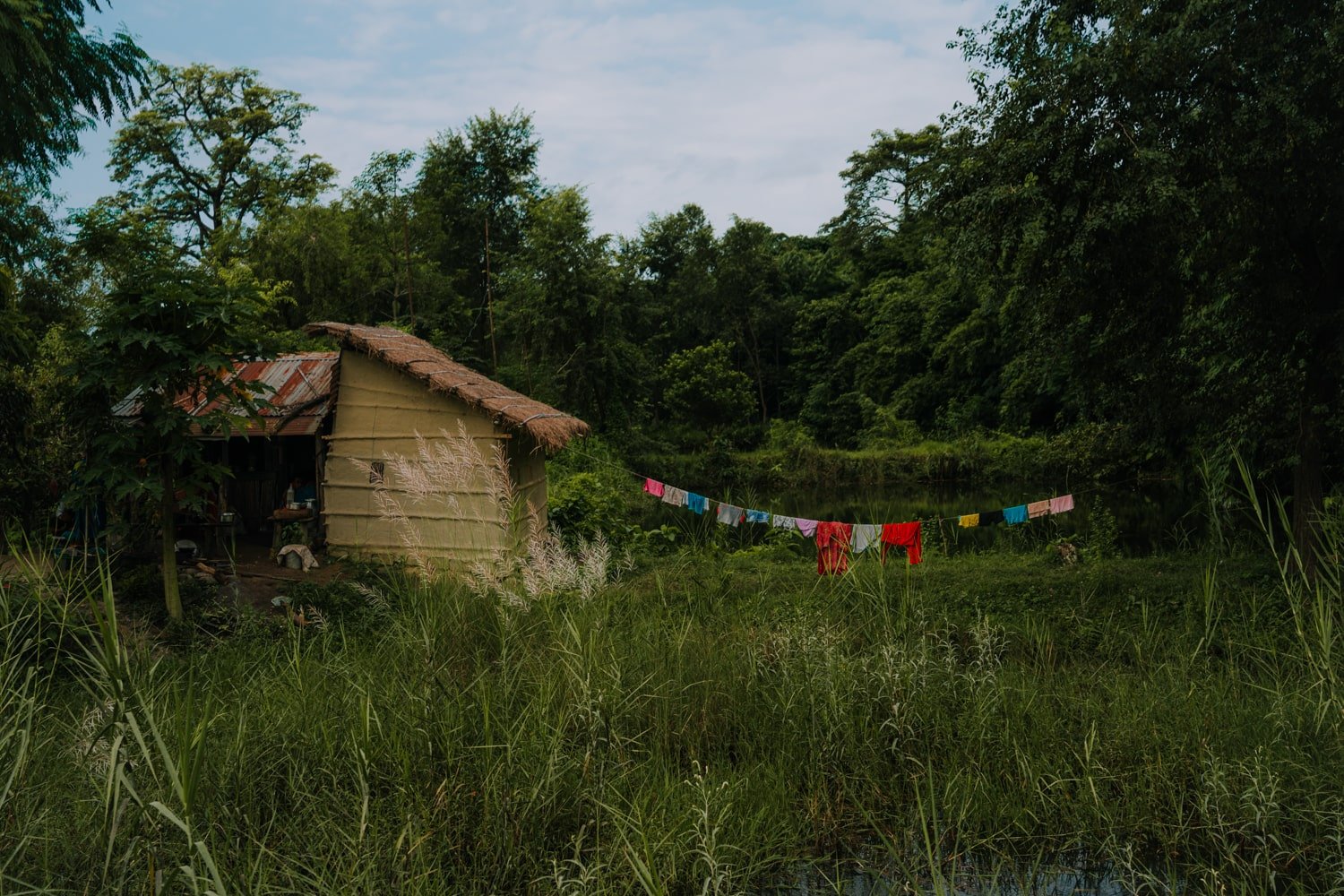
Activities & Things to Do at Your Barauli Homestay in Chitwan
Jeep Safari in Chitwan National Park
Through your Barauli homestay, you can go on a half-day jeep safari through Chitwan National Park.
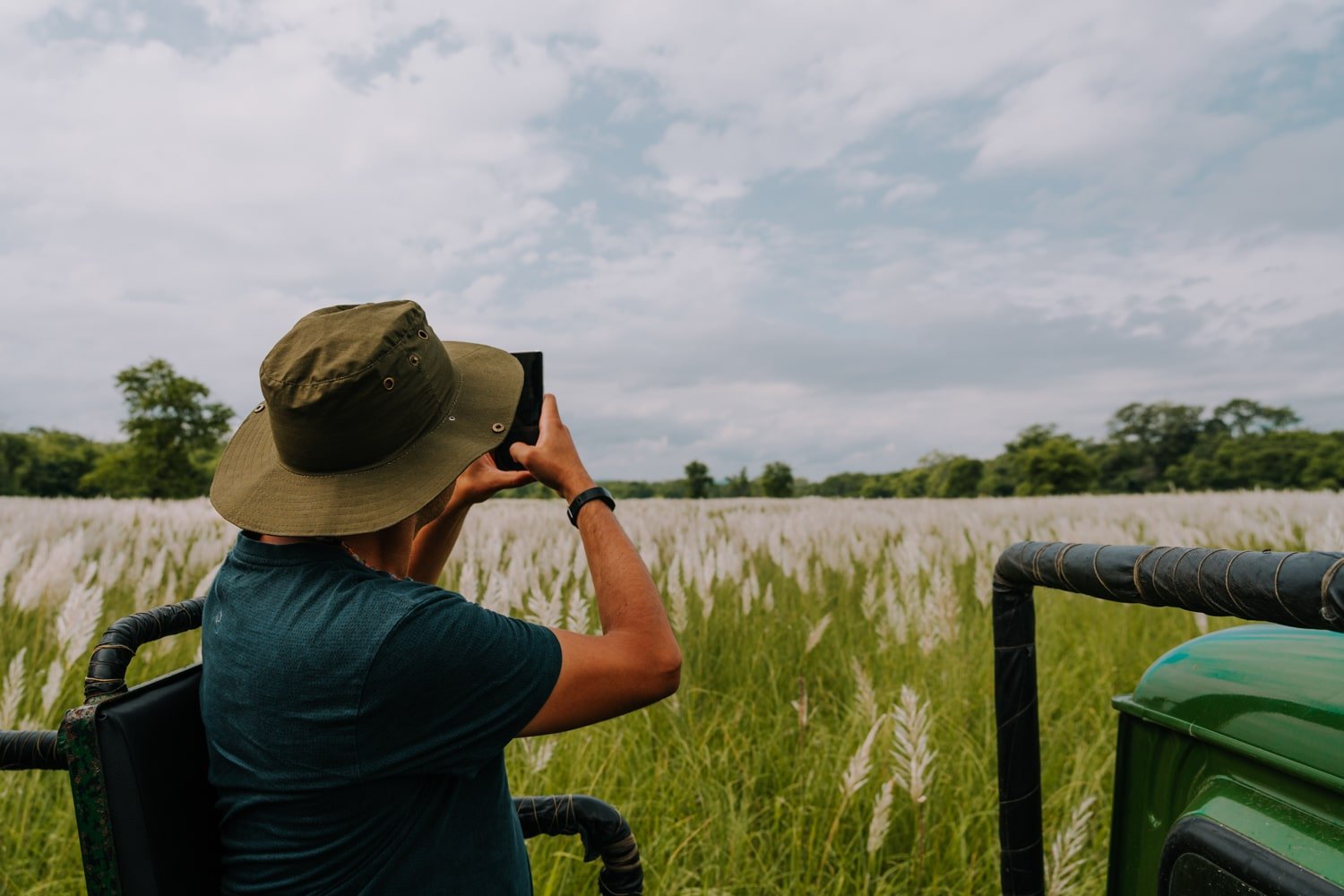
Chitwan National Park has abundant wildlife including over 55 mammal species, 525+ bird species, 55 amphibians and reptiles, and even 50+ types of grass including giant stalks of elephant grass, the largest of them all (source).
Wild rhinos, Royal Bengal tigers, elephants, monkeys, pythons, black/white storks, hundreds of bird species, and more, all call Chitwan National Park home.
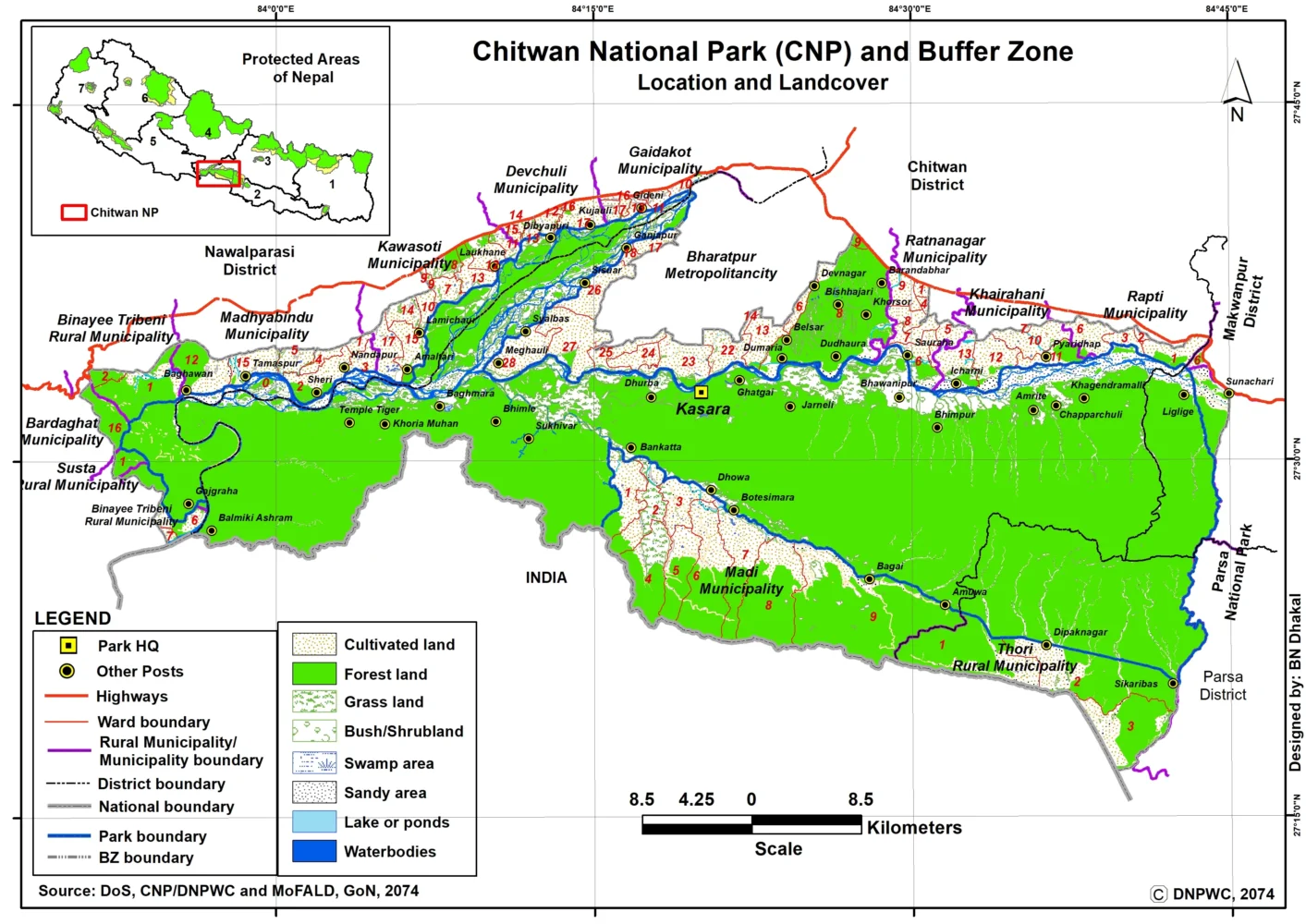
So what animals can you see in Chitwan National Park?
During your Chitwan jeep safari, you might get to see greater one-horned rhinos (we saw nine!), plus deer, monkeys, crocodiles, sloth bears, and birds.
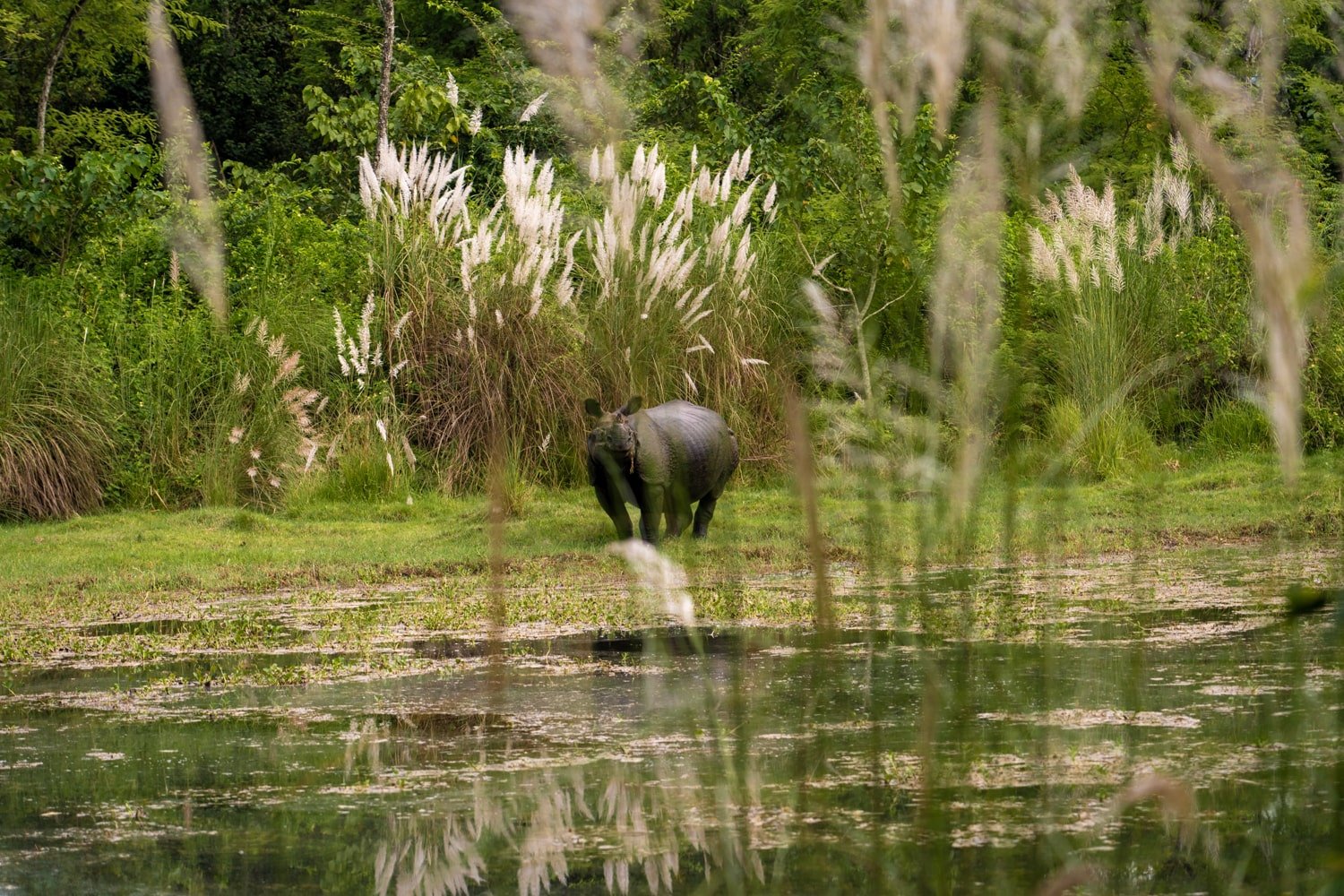
It’s rare to see a wild tiger or elephant, although you may see their prints in fresh mud!
Everyone’s Chitwan safari experience is different, so keep in mind that you might not get to see the animal you were hoping for.
The thrilling jeep ride and scenic views all make it worth it, though!
Please consider not riding elephants on safari in Chitwan: Unfortunately, many of the lodges/hotels around Chitwan National Park have captive elephants for tourists to ride on safari. Please do not support these hotels nor go on an elephant ride. We saw a few elephants chained in captivity and they are very sad.
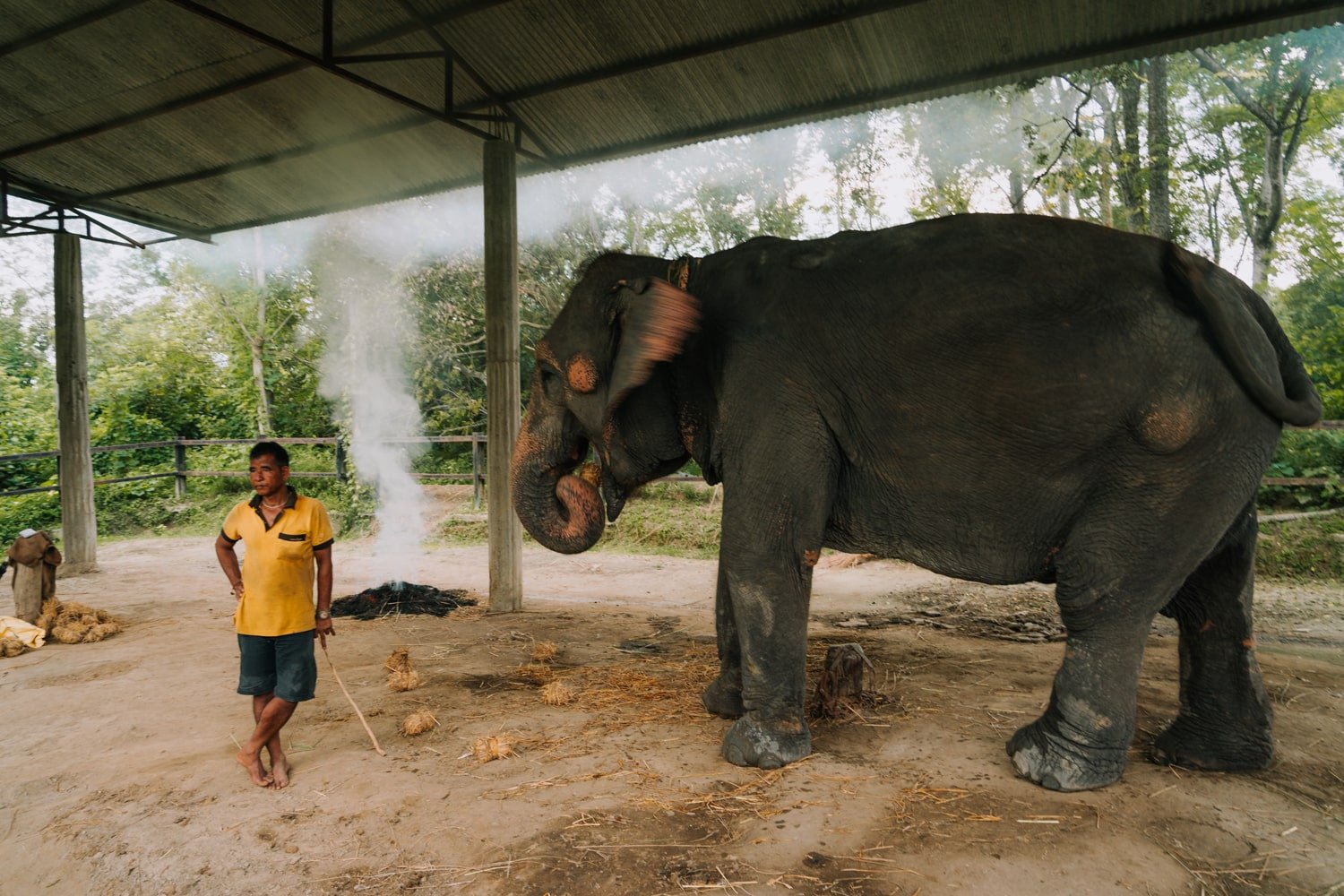
Below are more responsible tourist things you can do in Chitwan and Barauli!
Cooking Class with the Tharu Locals
One of the activities you can sign up for through the Barauli Homestay is a cooking class—the Art of Tharu Cooking.
And let me just say that this was a highlight of my time in Chitwan!
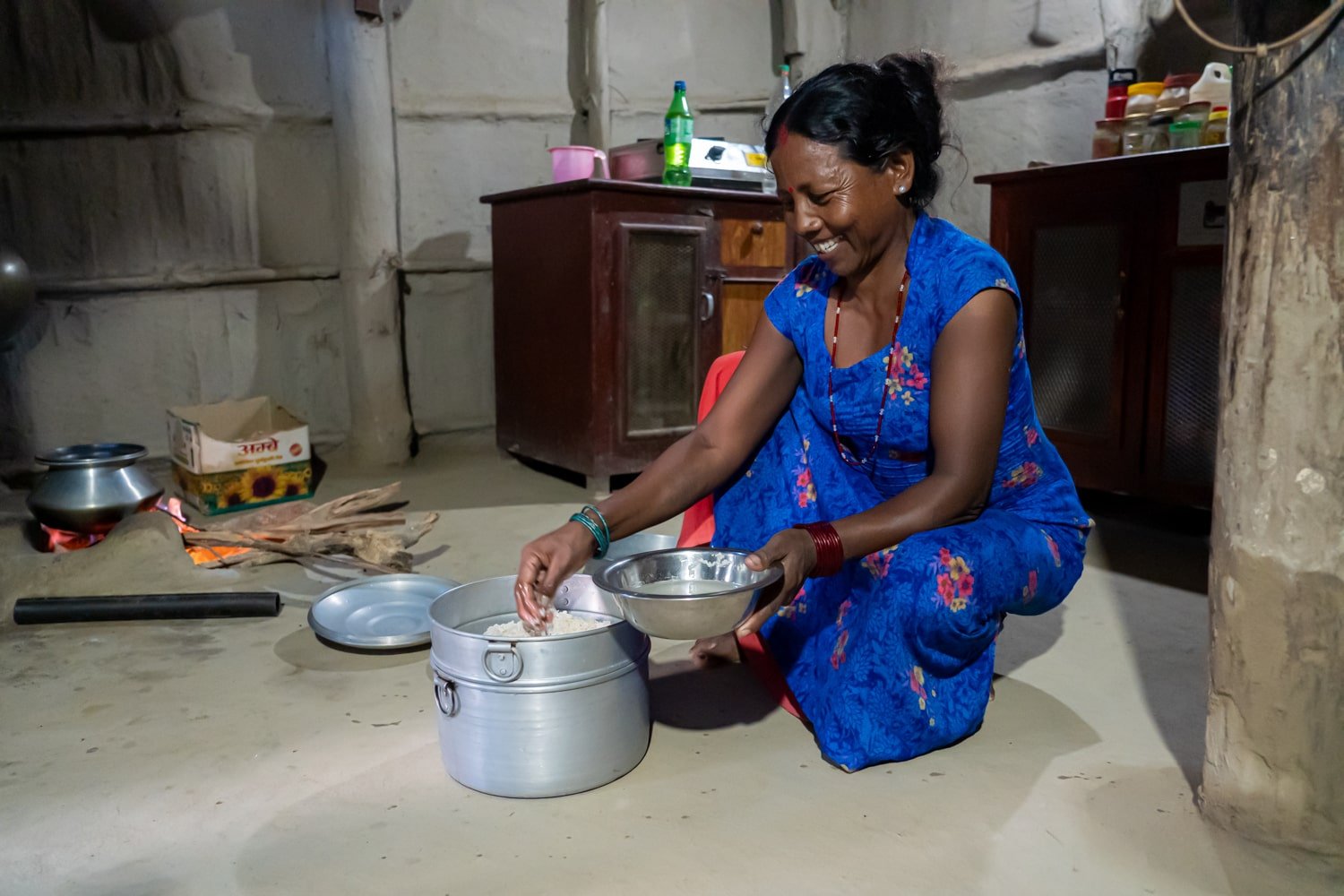

I was invited over to Teji’s house, one of the women living on the homestay grounds, and together we made steamed chapati, masala fish curry, egg curry, sauteed spinach, and rice!
I loved this experience because we got to prepare a typical homemade together and then enjoy it together.
This was quite the hands-on experience as well, which made it all the more fun—from crushing the garlic and spices on a stone slab outside to seasoning the masala gravy just right to adding oil in the pan over a crackling open fire inside.
The best part was getting to spend the evening together. Teji and her husband were such kind and friendly hosts. And thanks to my guides Shambhu and Tej for acting as translators, I was able to learn a lot about her family.
When you visit Chitwan, this activity will certainly set your experience apart!
Walking and Biking Around the Barauli Village
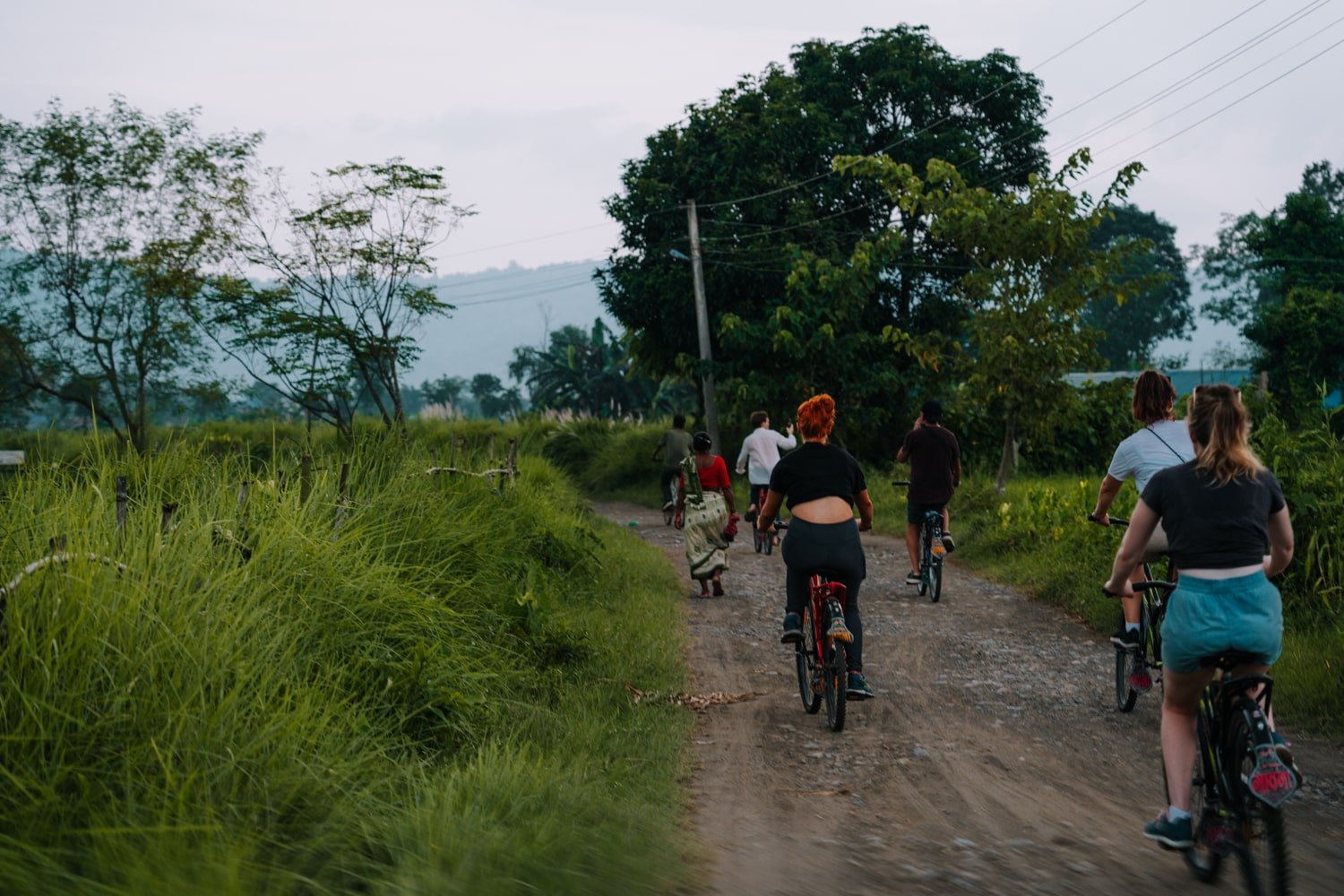
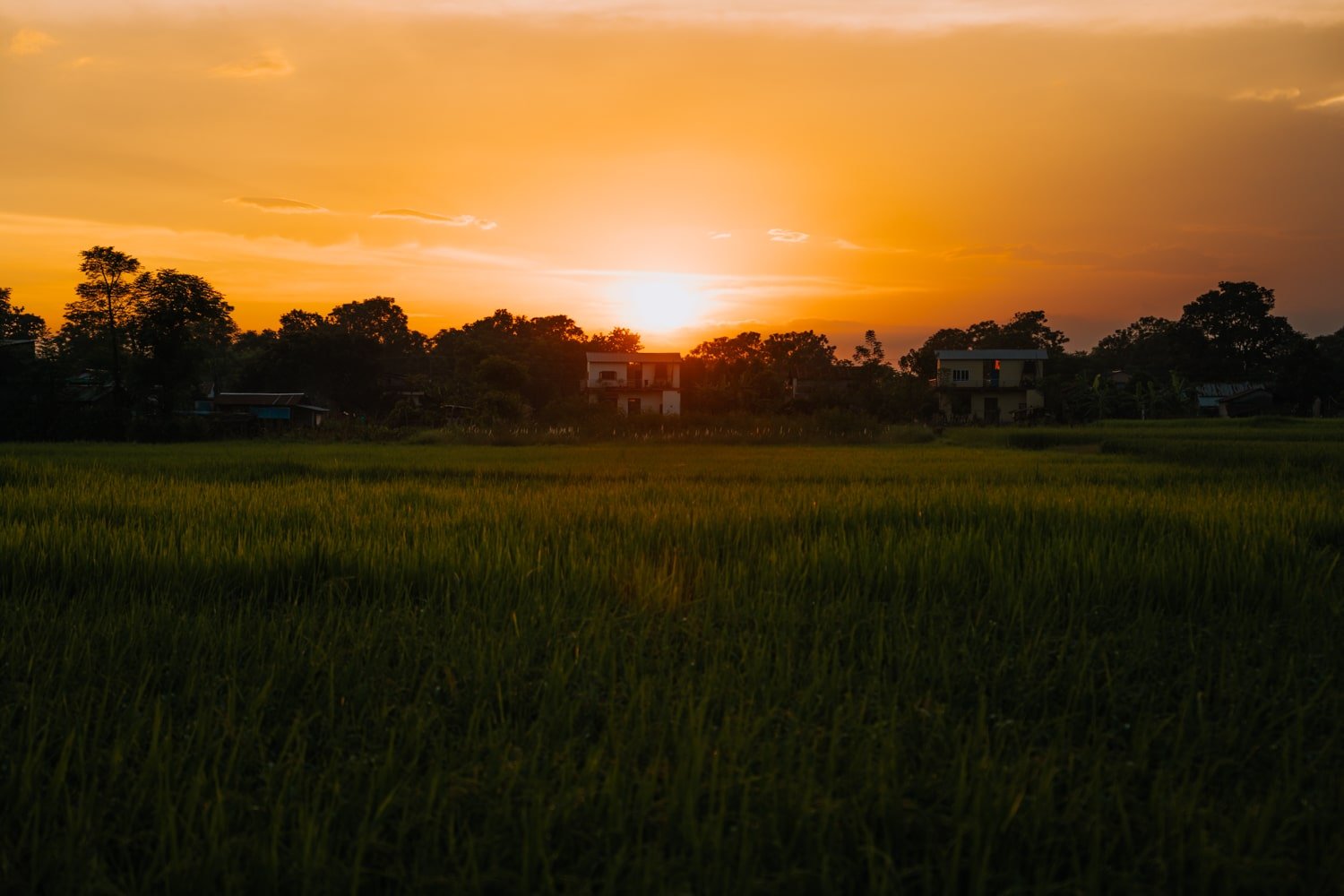
Another thing you can do when staying in Barauli is go on a sunset bike ride through the village to the Narayani River.
This is a lovely experience that takes you on a fun and easy ride past rice fields and through the village where you’ll see typical Tharu homes and families going about their daily lives.
If you have good weather, you can enjoy the sunset over the Narayani River while sipping on masala tea.
Even though it started to rain during our outing, I was grateful for the refreshing raindrops as Chitwan in early September was still very hot and humid!
Tharu Women Cultural Dance Show
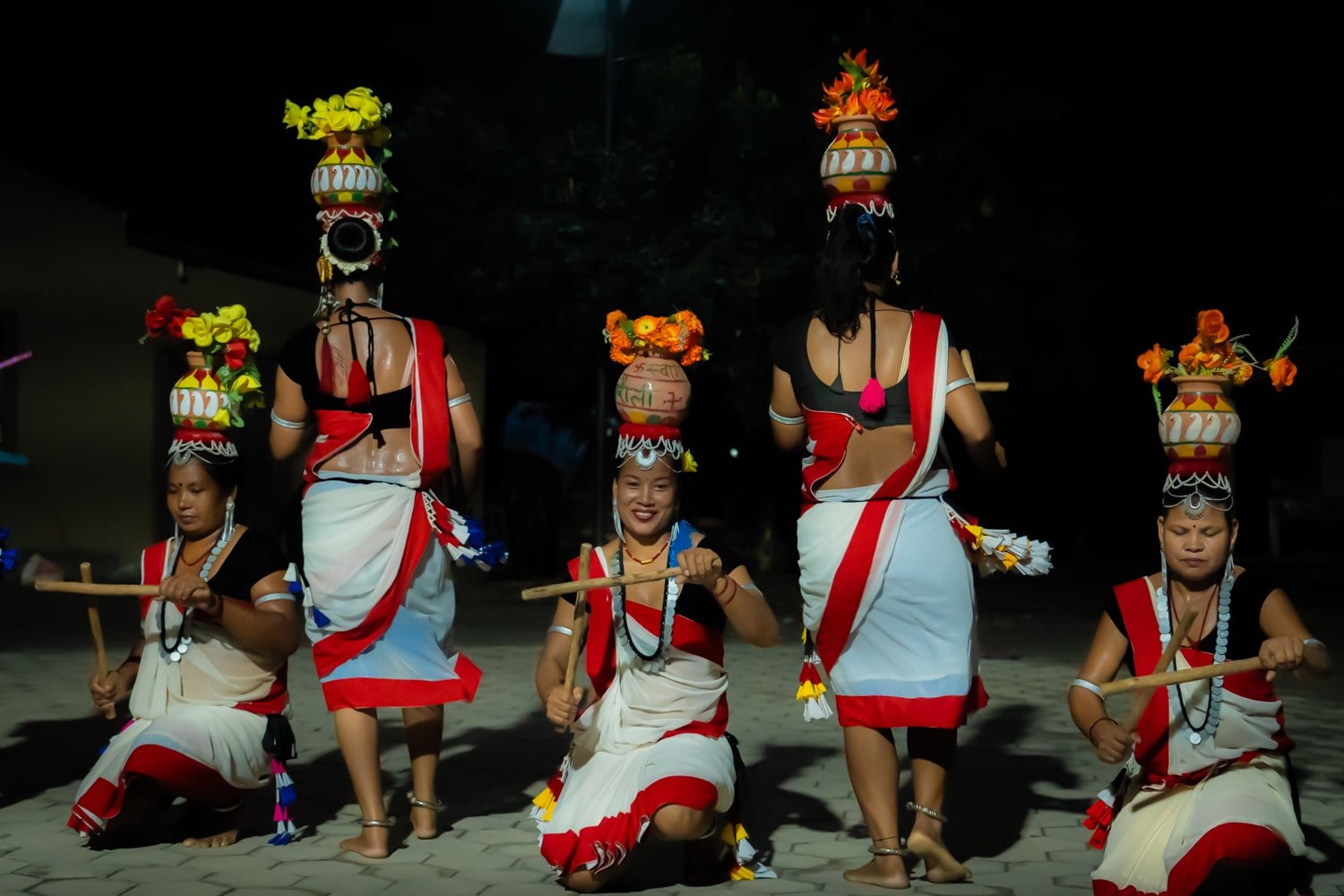
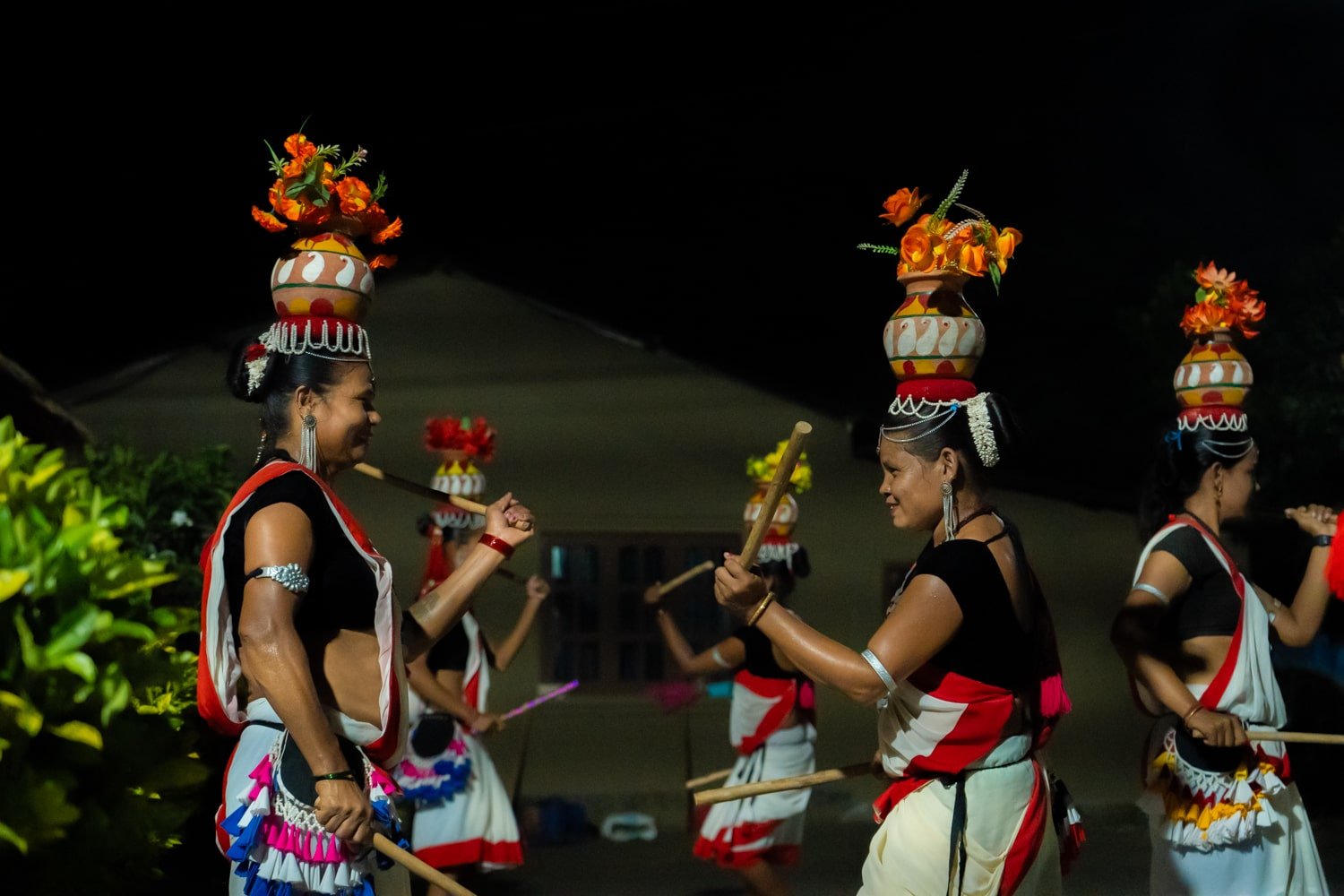
During your stay at Barauli, you’ll have the wonderful opportunity to watch the Tharu community come together to perform four traditional dances such as the Bhajayati, Thekara, and Dafu dances which feature drums and sticks.
I absolutely felt the joy coming from the women dancing and loved getting up to participate and join in on the fun at the end of the evening!
The show takes place in the evening in the homestay’s courtyard. So sit back, relax, and enjoy the show (popcorn is served!).
Fun fact: The sticks featured in these dances were once used to ward off animals when the Tharu indigenous lived inside the park (before park boundaries were drawn and Chitwan became a protected area).
Fishing with Locals
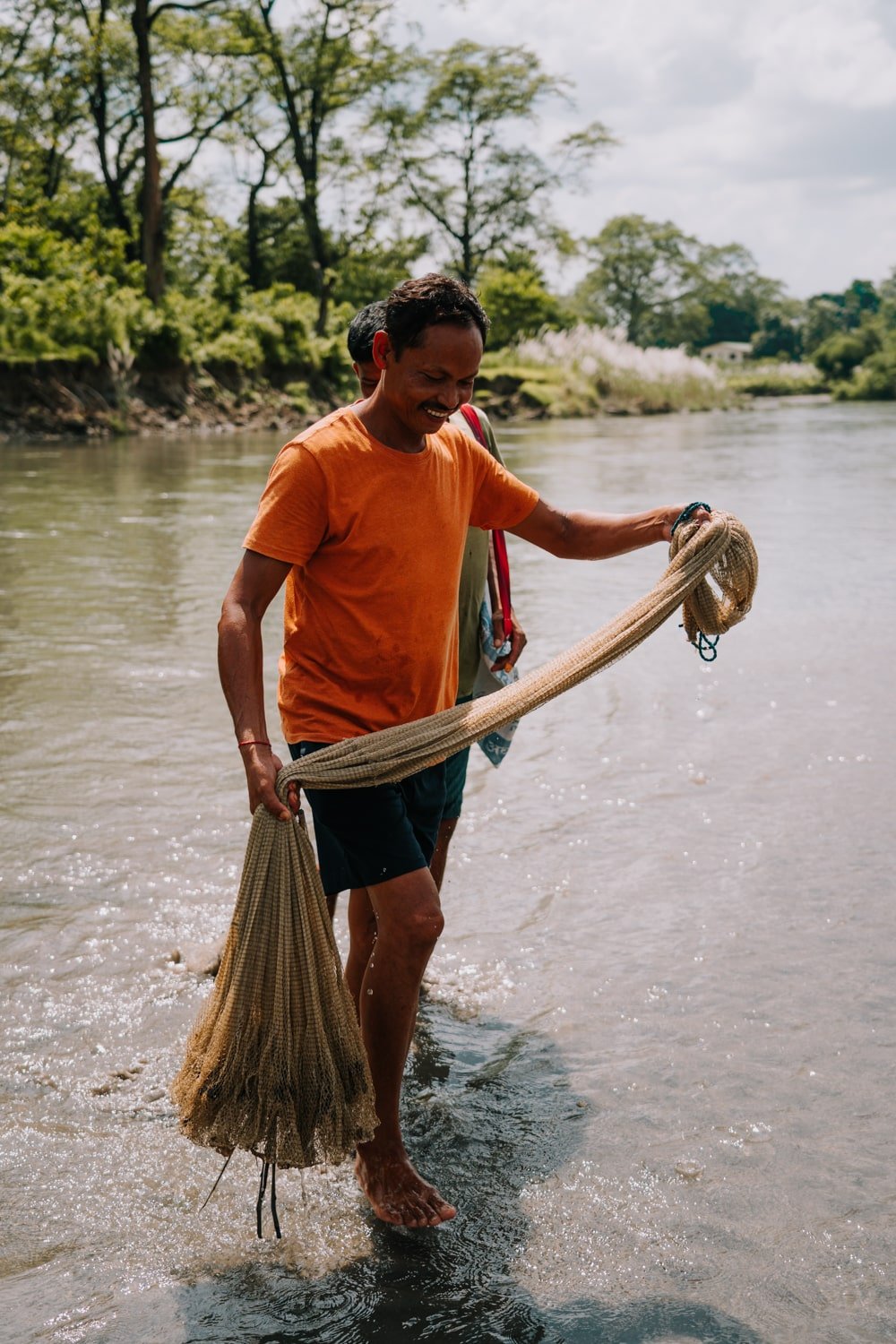
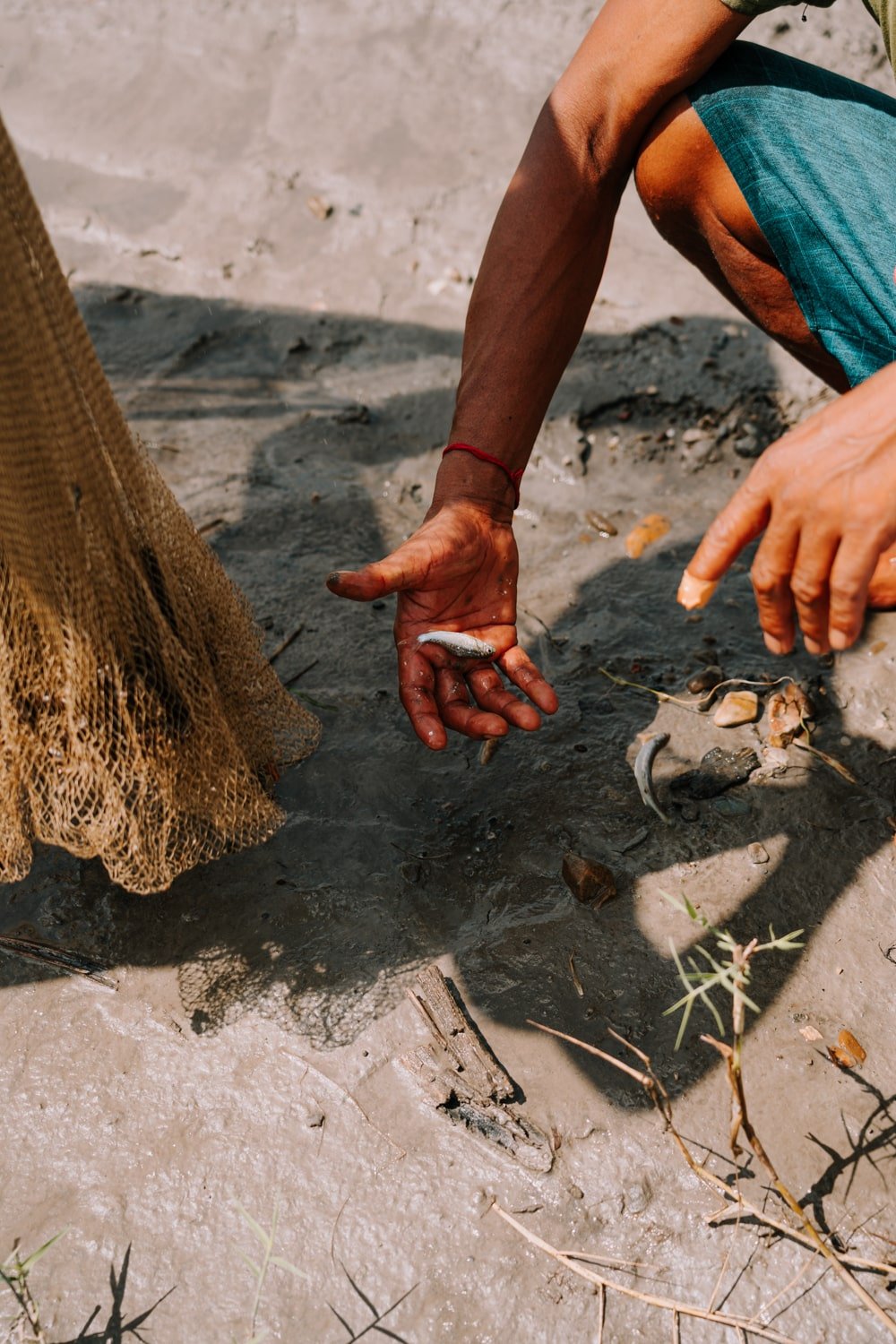
Fishing may not be your muse, but to accompany the Barauli locals on a little fishing adventure is quite fun!
We went to the nearby river where water buffalo were submerged, taking respite from the hot Chitwan sun, and where kids were playing.
Wading through the mud barefoot might’ve felt “icky” at times, but I was happy to get dirty and snap photos whilst my guides carefully cast their traditional-style nets, trapping 2-inch-sized little fish in their web.
(Fish that turned into a tasty fish curry made my Shambhu upon our return to the homestay!)
Birding with Shambhu
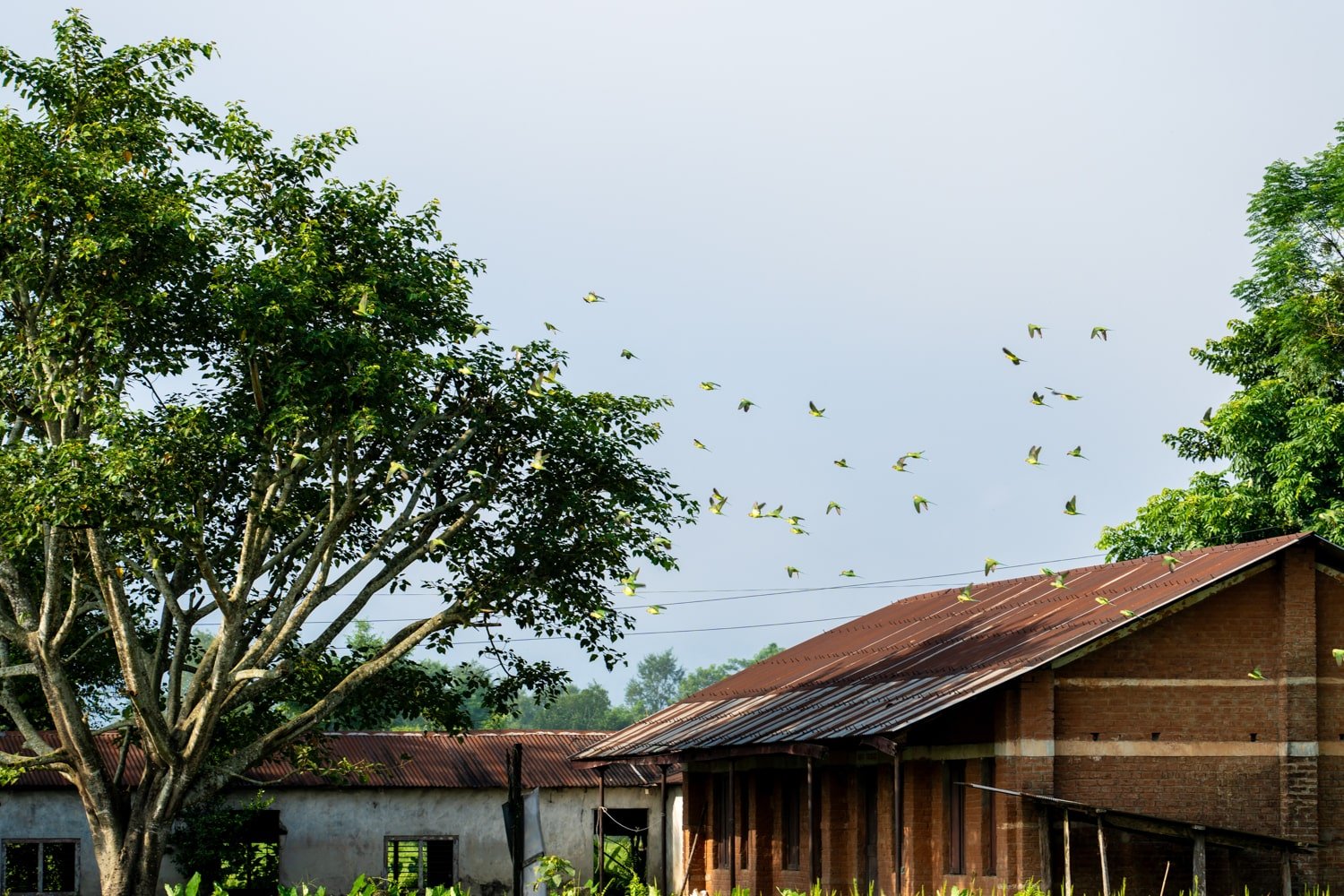
Another wonderful activity I got to do was go birding with my guide Shambhu, whose eyes for spotting bird species are just as sharp as an eagle’s.
Shambhu knows hundreds of bird species by heart and can recognize them in an instant.
✨ Half of my enjoyment of birding was just observing Shambhu point and reveal all that he spotted: adorable owlets hidden high up in the trees, bulbuls perched on powerlines, storks standing in puddles of water, parakeets stealing from rice stalks in the fields!
All of the above experiences made my time in Barauli, Chitwan so rich and memorable and I believe this could be the case for you, too!
Now…
What Is the Tharu Barauli Homestay Really Like?
The Barauli Homestay is a well-established homestay in the Community Homestay network, having got its start in October 2014.
That said, it has had time to improve its offerings for guests, providing comfortable private rooms, a dining hall, a full-service bar, Wi-Fi, and more.
The Accommodation
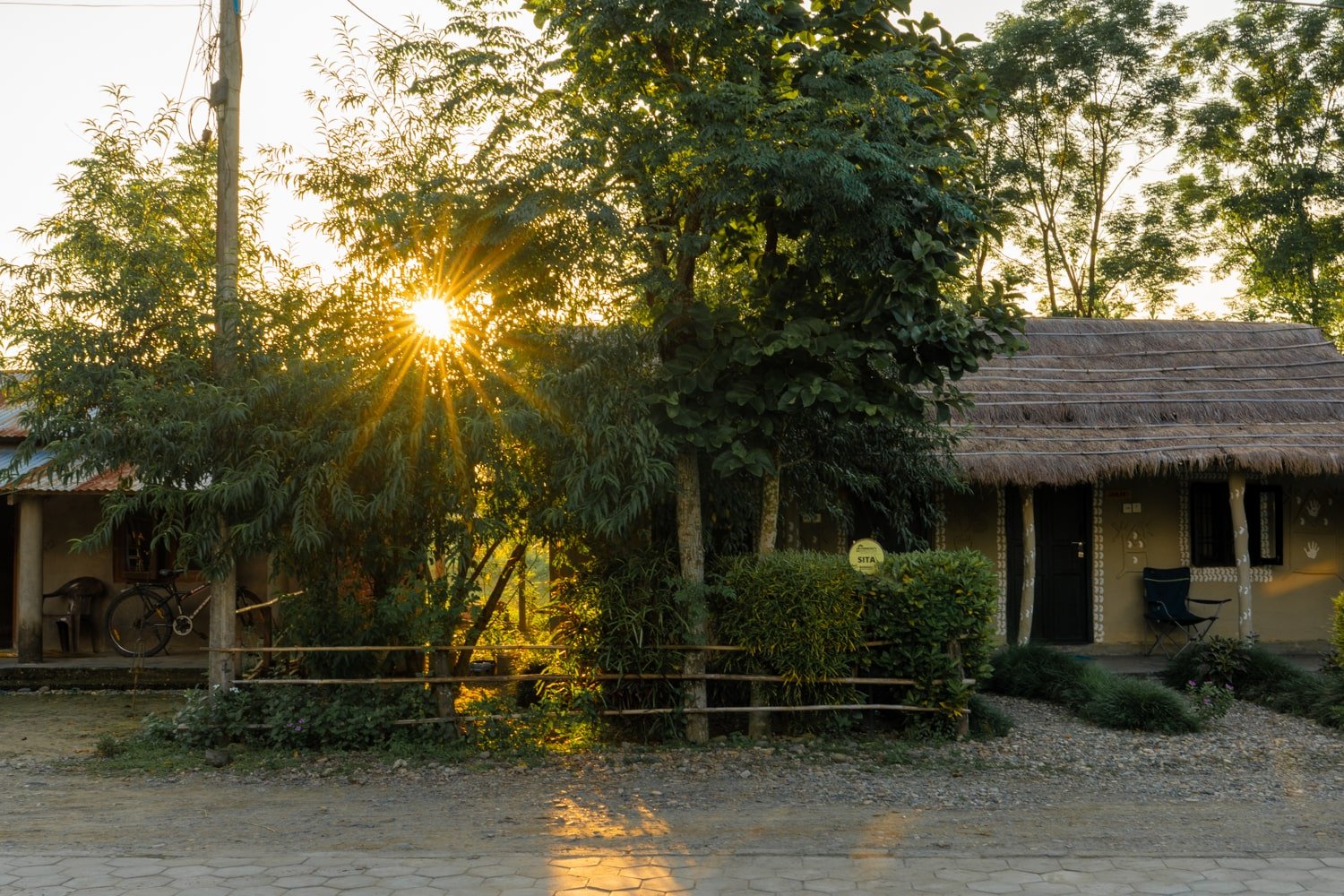
The Barauli homestay features thirteen huts—each individually owned and named after the woman in the community to whom it belongs—totaling twenty private rooms equipped with attached bathrooms with solar shower water, a flush toilet, ceiling fans, and comfy beds with mosquito nets.
Other homestays through the CHN aren’t all set up this way with separate rooms, however, it works well for Barauli as you can still get the experience of being among the Tharu locals while having your own privacy.
I stayed in Sita’s guesthouse, located right across from the dining hall. She lives just next door (to the left).
While you aren’t staying in the women’s homes, they are very welcoming and are happy to have you over (although, you might want to ask your guide or one of the staff members to help translate).
My guide, Shambhu, was extremely helpful and patient as I basically followed him around everywhere and asked him tons of questions (lol—thank you, Shambhu!). 😃
The Community Dining Hall
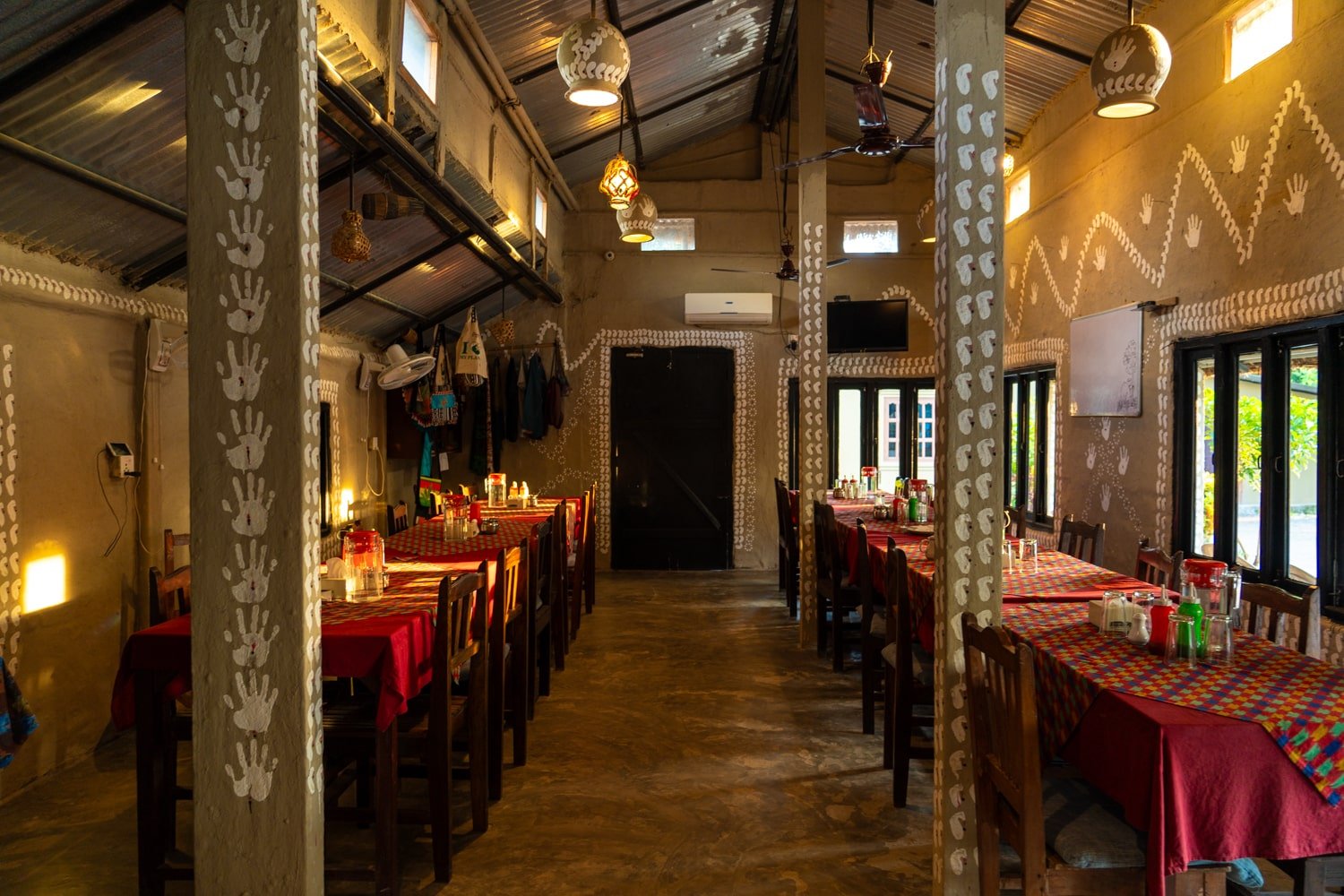
All meals are served inside the beautiful community dining hall which also features a bar and a little corner shop with Nepali souvenirs/products, some of which are handmade by the locals.
All of the homemade meals and crafted drinks were delicious and filling!
Lunch and dinner include typical Tharu and Nepali “sets” that come with soup or dhal, curried vegetables, chicken (vegetarian available), pickle/achar, and rice. Or you can order a single-menu item such as fried rice or noodles.
And for breakfast, my favorite items to order were yogurt with fresh fruit and crêpe-style pancakes with honey and banana.
The dining hall is where you can also connect to Wi-Fi during your homestay, although I’ll say that I got decent data service in Barauli, Chitwan with my Ncell sim card and my Google Fi e-sim.
The Homestay Grounds
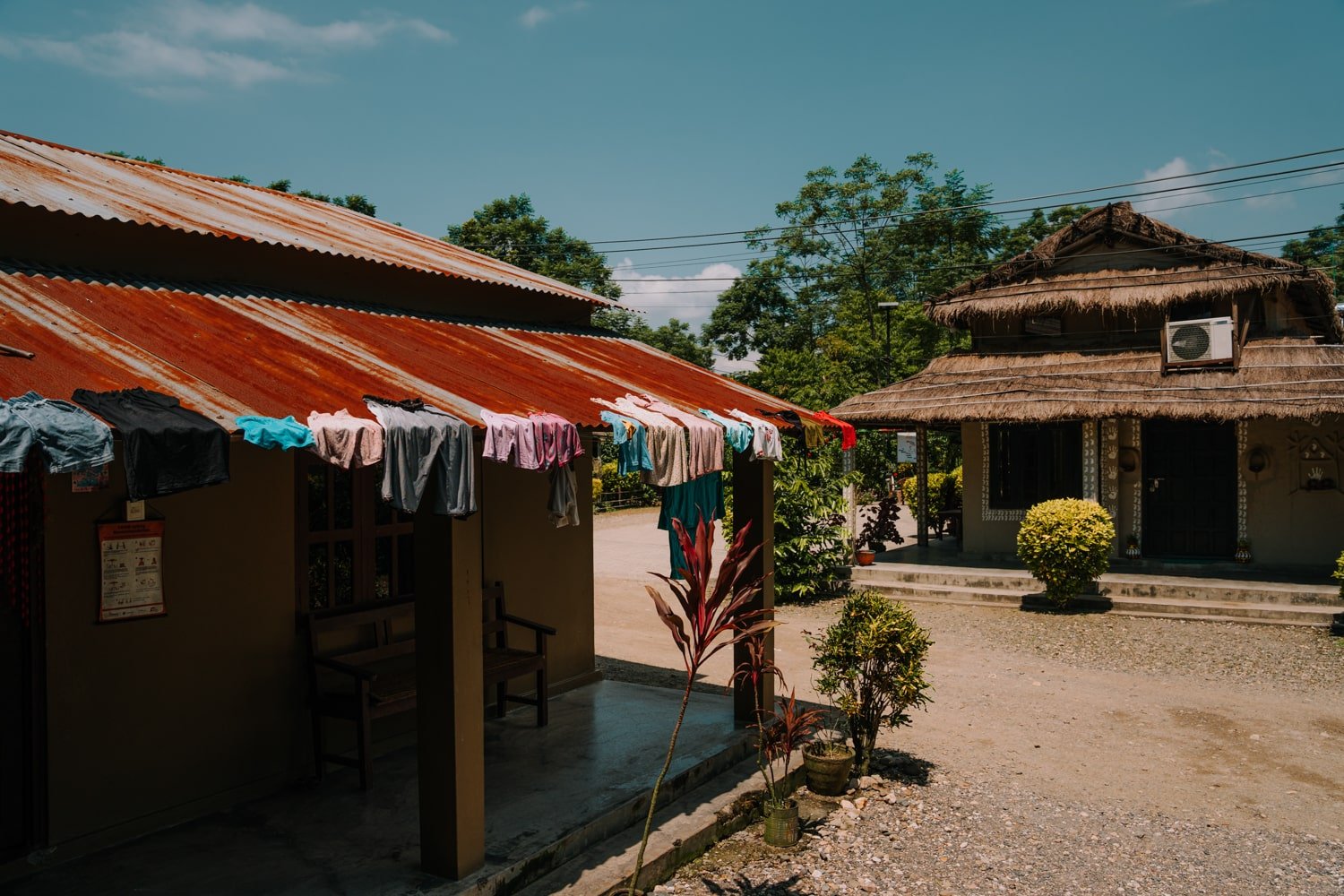
The homestay grounds include the families/women’s homes and thirteen guesthouses, with the dining hall as its centerpiece.
Each guesthouse is made with local materials, such as mud walls and thatch rooves, and is decorated with Tharu handprints and Chitwan wildlife in white paint.
Around the guesthouses are plants and chairs for relaxing. It’s very quiet in the homestay, so you will have a restful night’s sleep!
As for safety/security, you are living among the locals and couldn’t be in a better place. In addition, you will be given a key to your room for storing your belongings securely.
Is Barauli Homestay the Best Place to Stay in Chitwan?
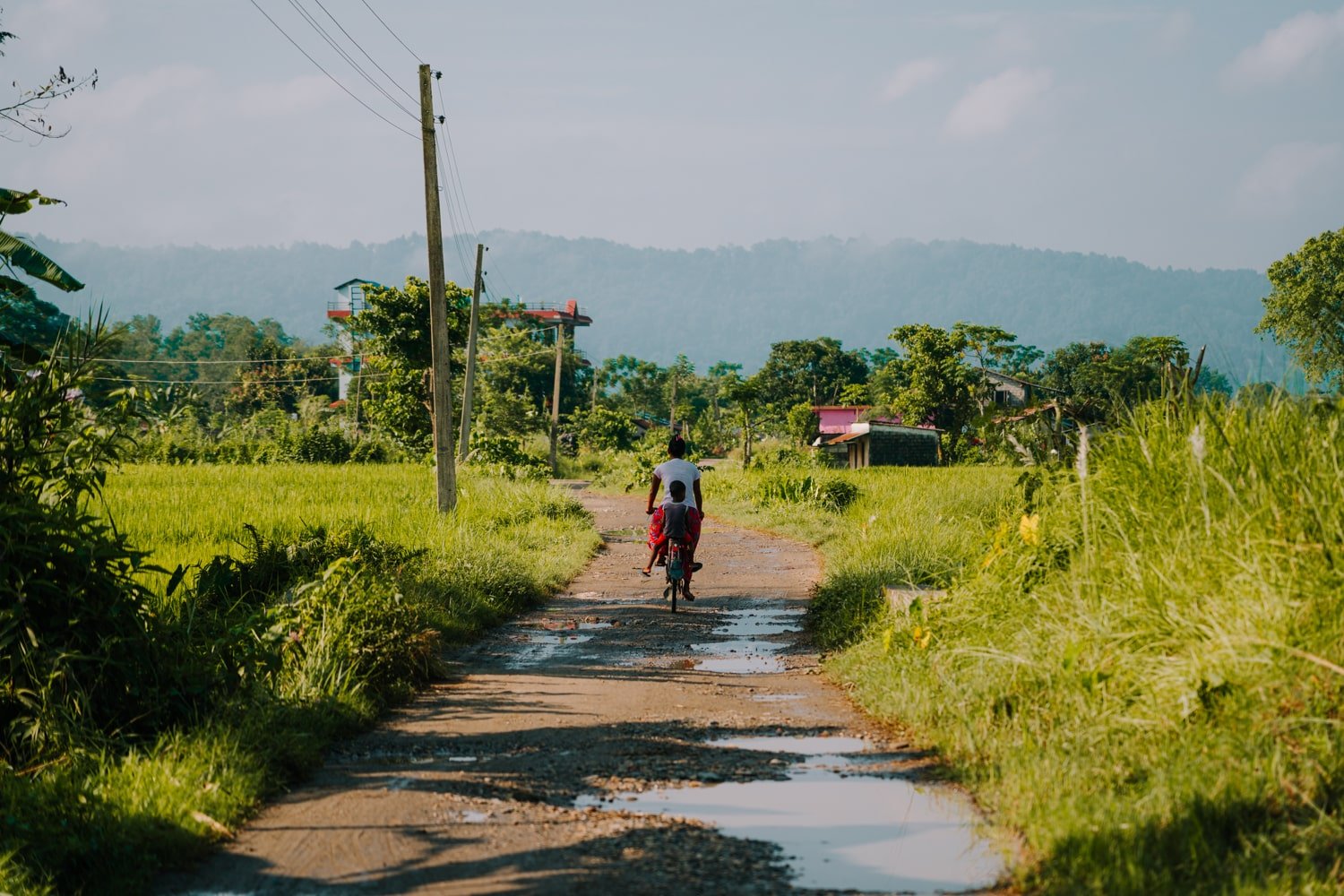
The Barauli Homestay staff and community have welcomed many tourists into their homes over the years, so at first, my experience felt more like a hotel rather than a homestay.
But after being there for three days, and being around other tourists passing through, I realized the experience is truly what you make of it.
Sure, you could retreat to your room and barely speak to the staff or locals or hang out only with the group/people you traveled with, but the value of this type of experience lies in your own curiosity and willingness to seek more.
I think Barauli offers more than “just a place to stay” near Chitwan National Park; it’s an opportunity to make your experience (not just in Chitwan, but in Nepal in general) all the more meaningful while having a positive impact on the local community and economy.
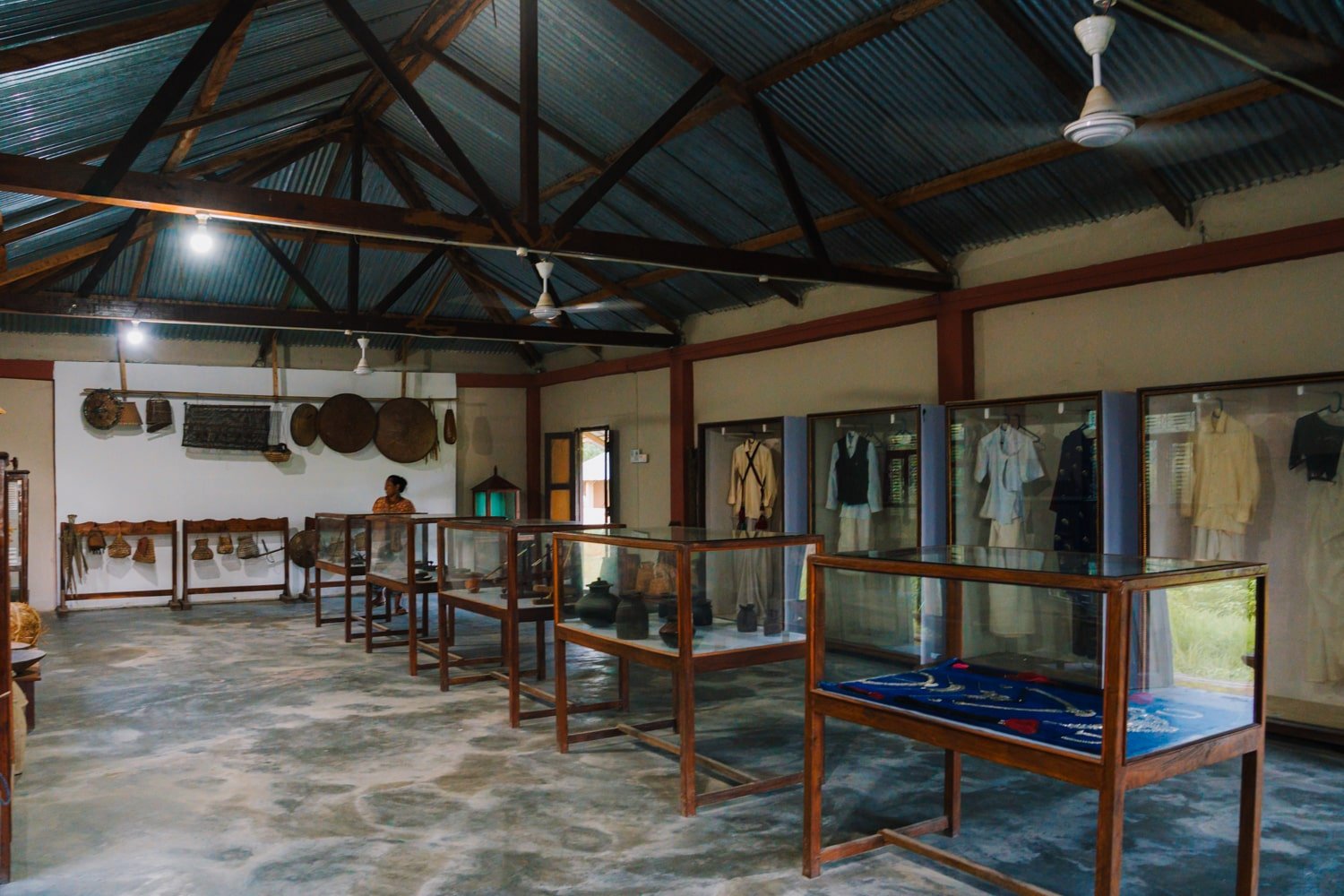
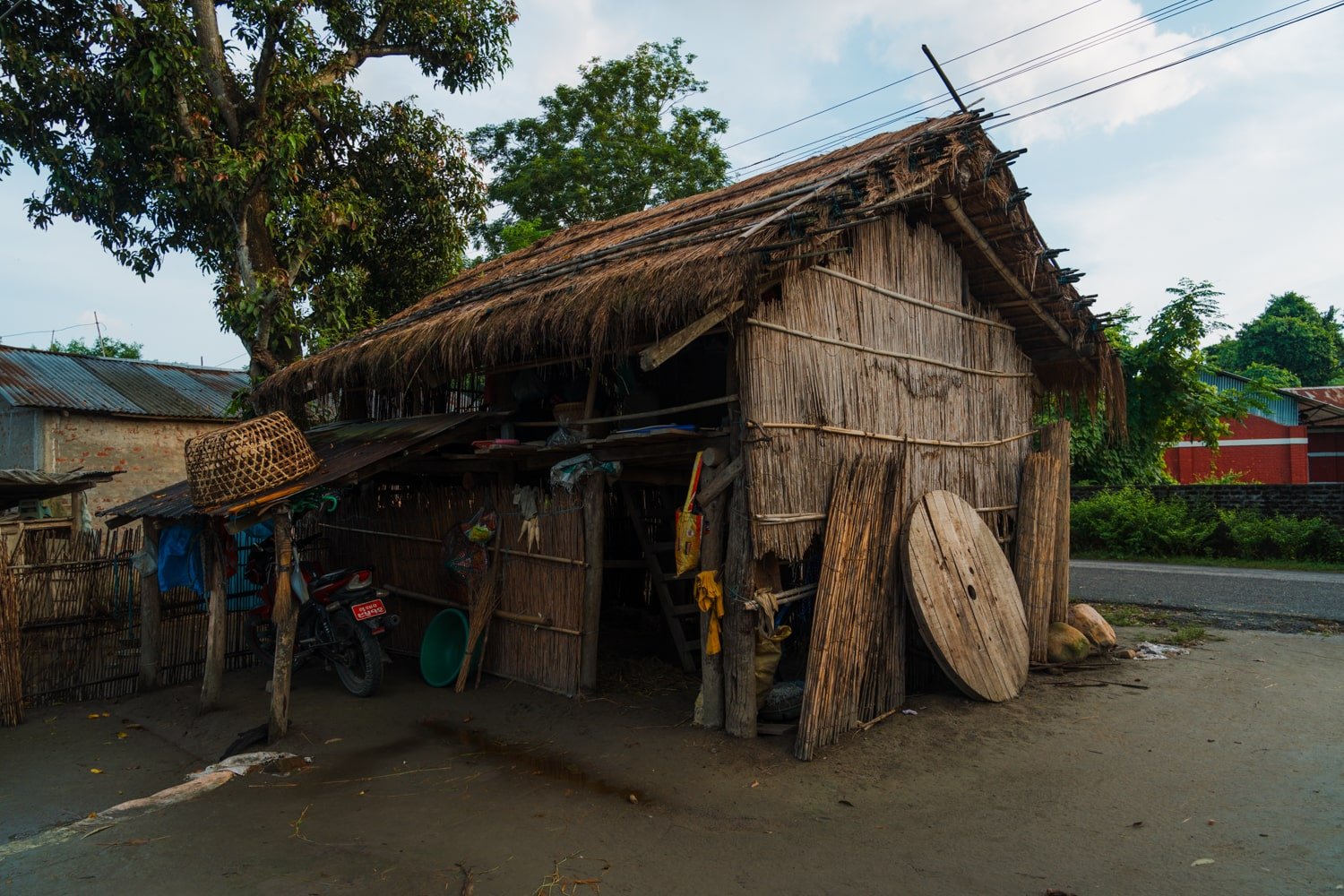
Practical Tips for Your Homestay in Chitwan
How Many Days/Nights Do You Need in Barauli, Chitwan?
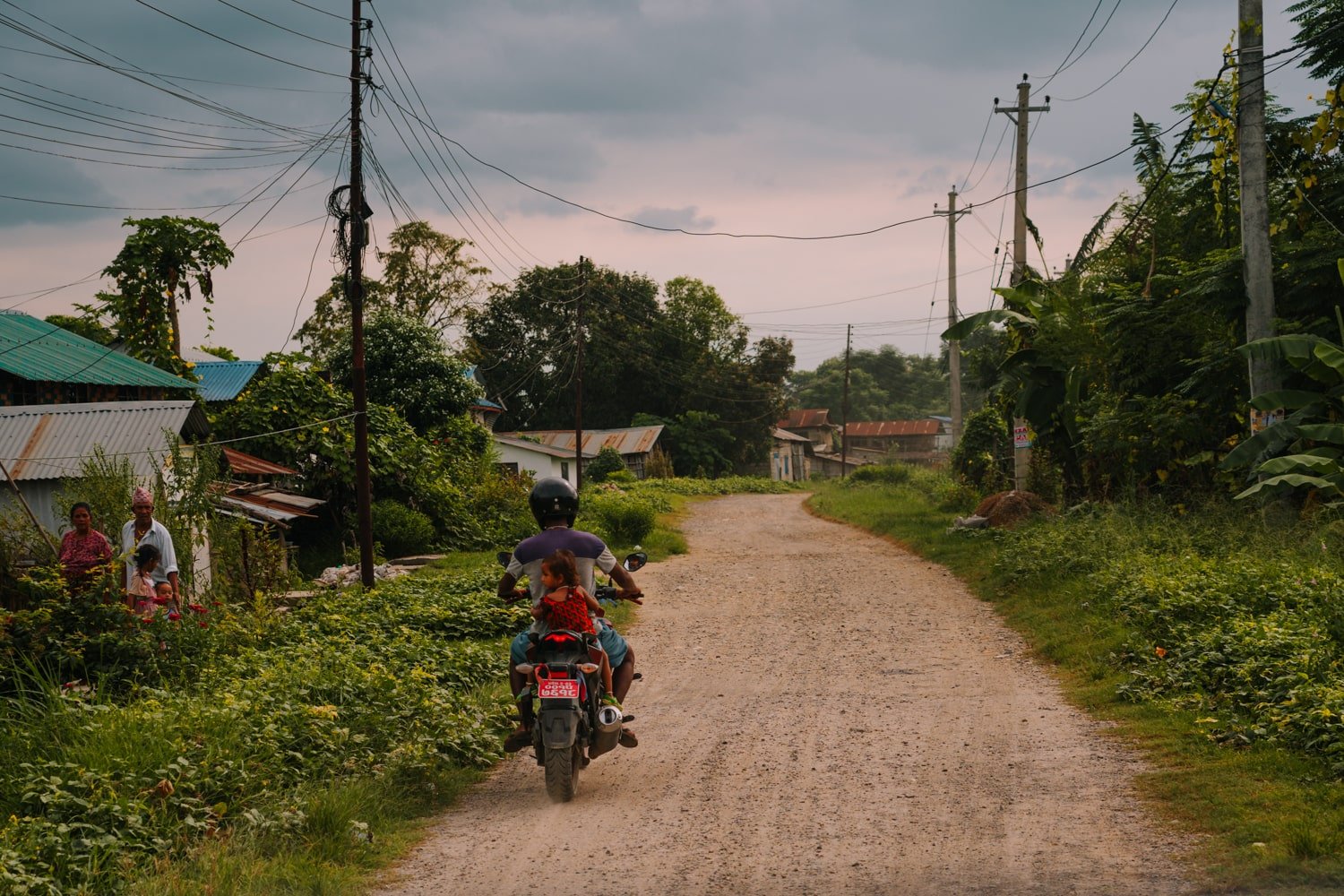
All that said, I’m very happy having spent three nights in the Barauli Homestay because, as I mentioned earlier, coming down to Chitwan just to visit the national park on safari would not have been worth it for me.
What made my time in Barauli, Chitwan invaluable was making new friendships and connections through the homestay, learning about the Tharu people first-hand, and participating in local activities.
That said, considering all there is to do around Barauli in Chitwan, you should stay a minimum of 2-3 nights (3-4 preferably if you want more downtime to relax instead of stuffing your days full).
How to Get to Barauli from Kathmandu
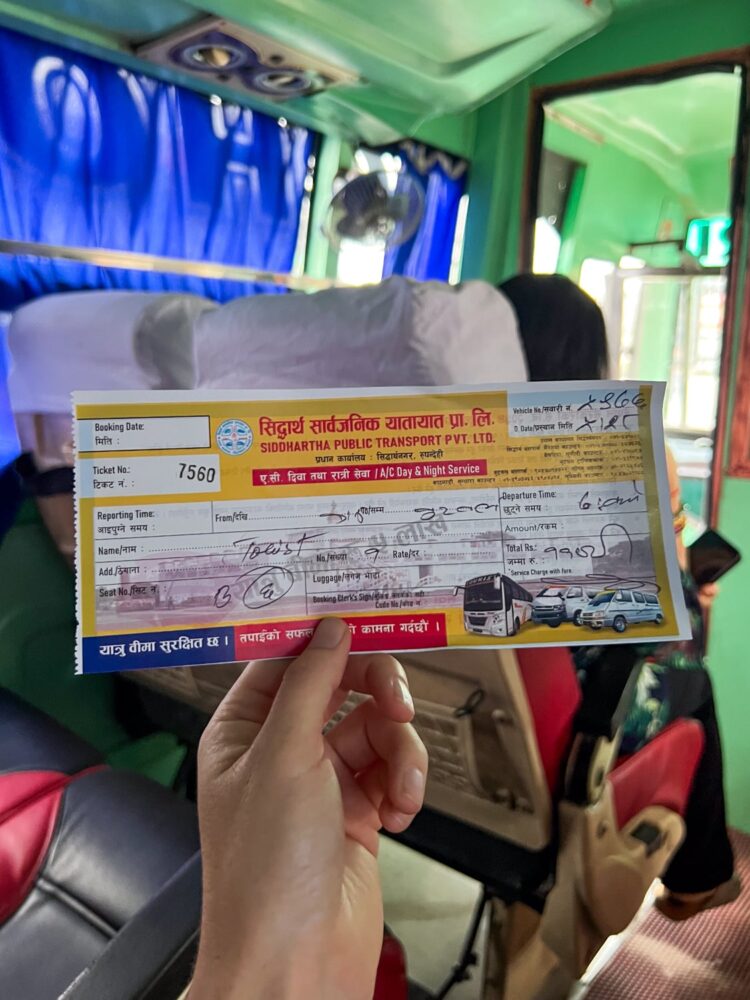
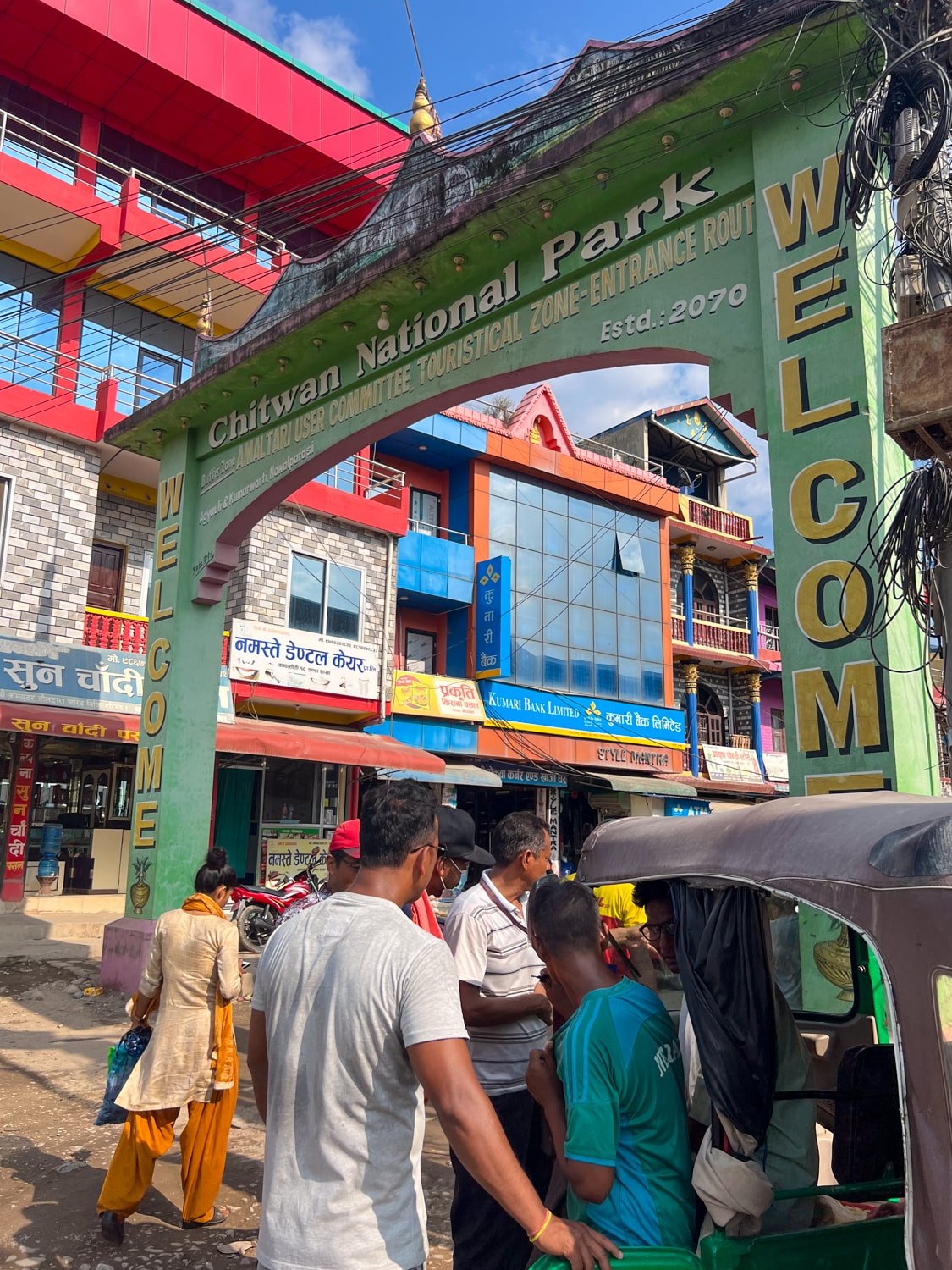
Barauli is approximately 190km from Kathmandu. By bus, it takes around 6-7 hours to get there.
To get your bus ticket from Kathamndu to Chitwan National Park, go to the Gongabu Bus Park early in the morning (6:30 a.m., for example) and purchase a ticket to Chitwan, mentioning that you wish to get dropped off at Danda Bazaar in Kawasoti (directions here).
The cost for the bus from Kathmandu to Chitwan should be around 1100 Rs. You will get a ticket and bus seat number.
Once you get dropped off at Danda Bazaar, you can go under the archway sign for “Chitwan” and ask a shared tuk-tuk to take you to the homestay for around 150 Rs. The ride will take around 15-20 minutes as you’ll be on bumpy dirt roads.
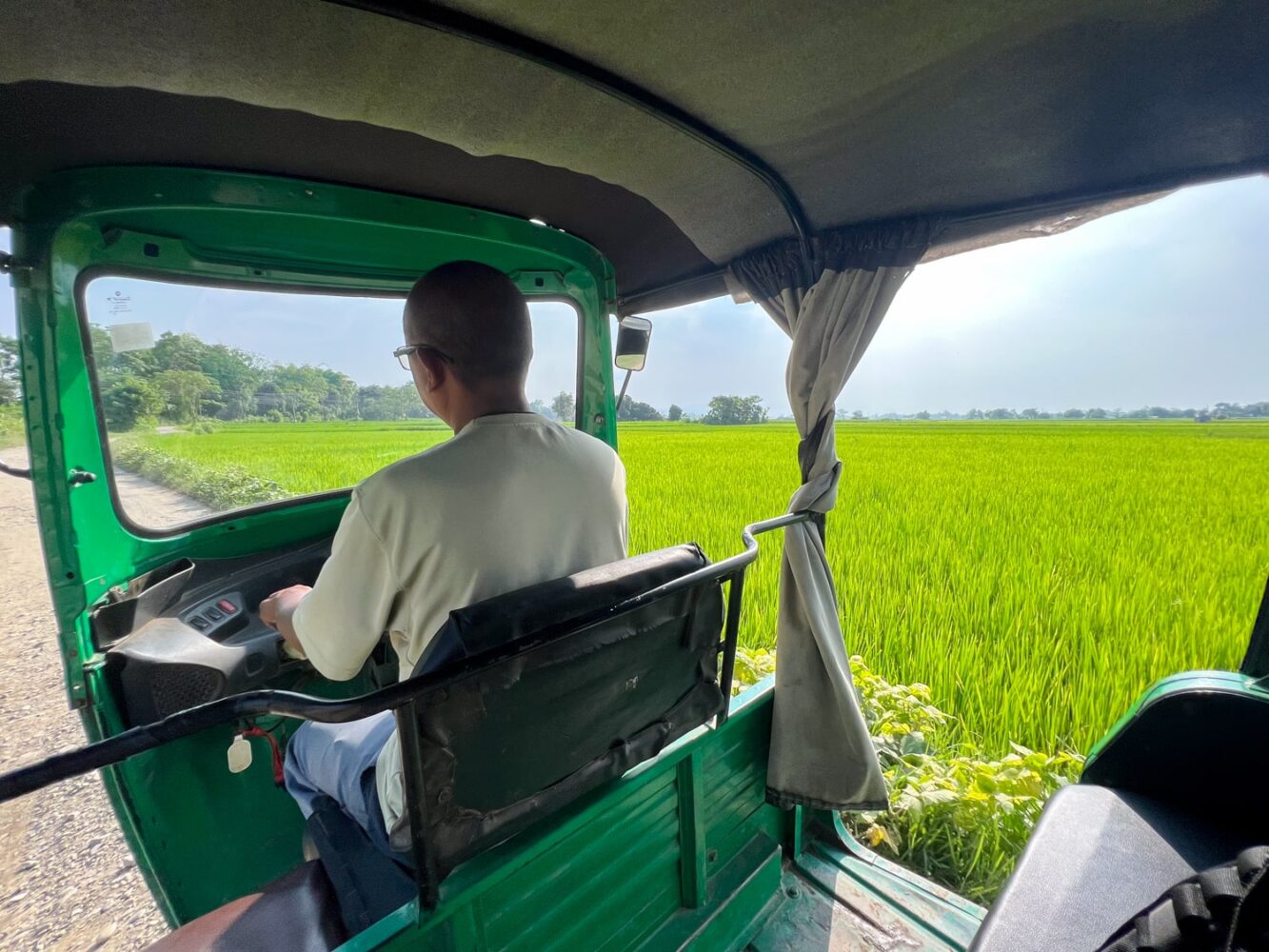
What to Pack for Barauli, Chitwan
Chitwan is quite hot and muggy, so you should pack and wear loose, breathable clothing.
I stayed in Barauli, Chitwan in mid-September and the temperature was still in the upper 80s and lower 90s (I was constantly sweating).
The best time to visit Chitwan is from October to February when the days are still warm but comfortable and nights are a bit cooler for sleeping.
In either case, you’ll want to wear comfortable, cool clothes such as cotton or linen shirts and pants.
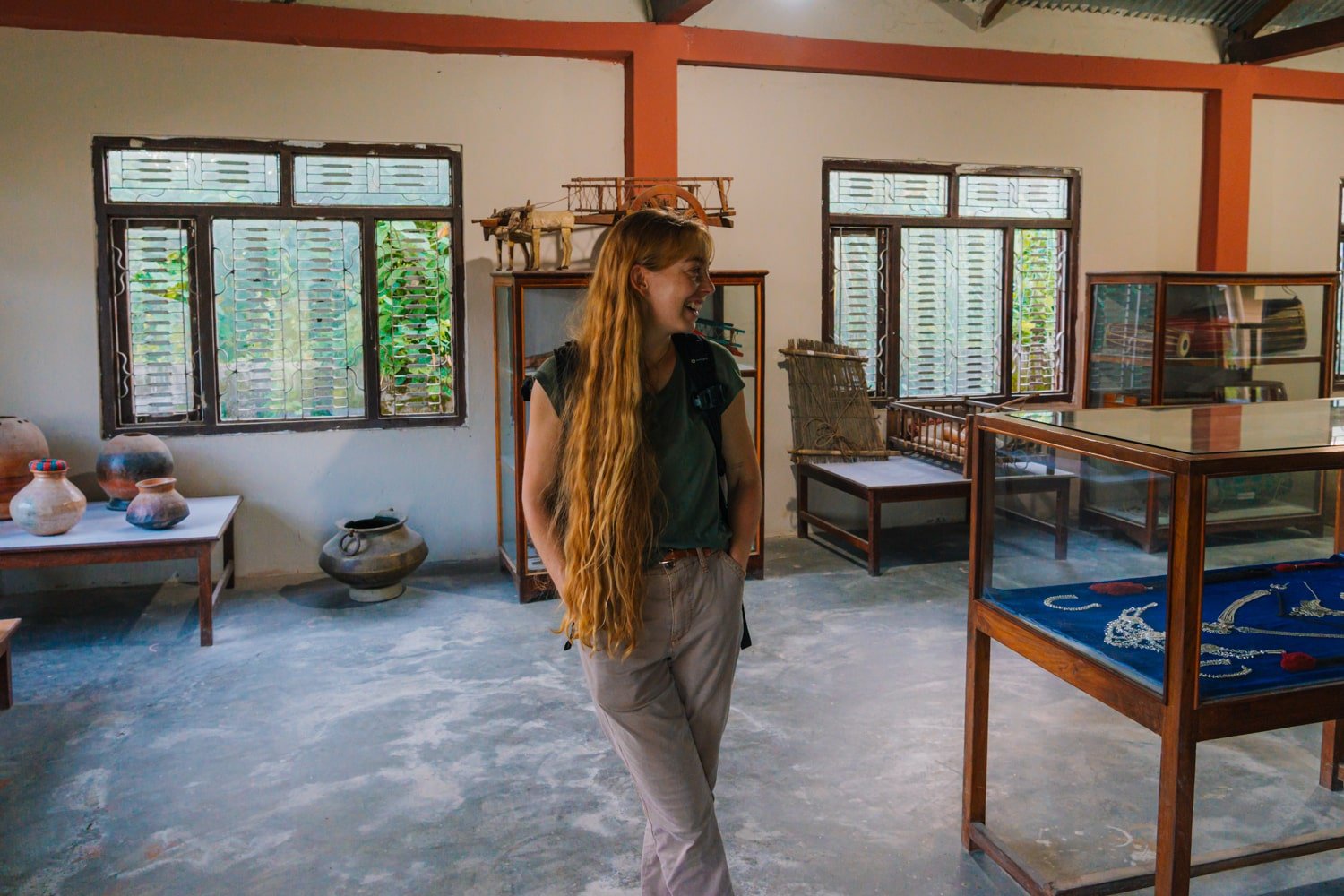
Chitwan Packing List
For a 3-4 night stay in Chitwan, I recommend packing:
- 2x loose pants, capris, or long shorts (avoid tight leggings, thick jeans, and short shorts)
- 3x shirts
- 1x loose long-sleeve (more for sun/mosquito protection)
- 1x sandals or shoes (I only took my Birkenstocks)
- Reusable water bottle
- Sunscreen, sun hat, sunglasses
- Optional – 1x light rain jacket or umbrella (I had neither but my clothes dried quickly under the fan in my room)
- Optional – 1x light sweater for cooler evenings/mornings
I also packed my journal, Sony full-frame camera, laptop, water bottle, and toiletries (which are very minimal, including my eye contacts, toothbrush/paste, and a natural shampoo bar).
The homestay provides a towel, body wash, and shampoo/conditioner so you don’t need to pack these items.
Keep in mind that Chitwan National Park is jungly, so expect mosquitos and critters. Mosquito spray/balm is a good idea, as well as sunscreen, sunglasses, and a hat for sun protection. ☀️
For your safari, in particular, plan to wear loose, long shirts and pants to cover up from the sun.
Otherwise, if you wear shorts like I did, you’ll get sticky and sweat off the sunscreen. Long but comfortable trousers or slacks might be better as well since you will do a bit of walking in the bushes. Not to mention, the open-air jeep ride can get buggy and cobweb-y!
Final Thoughts: Is the Barauli Homestay in Chitwan Worth It?
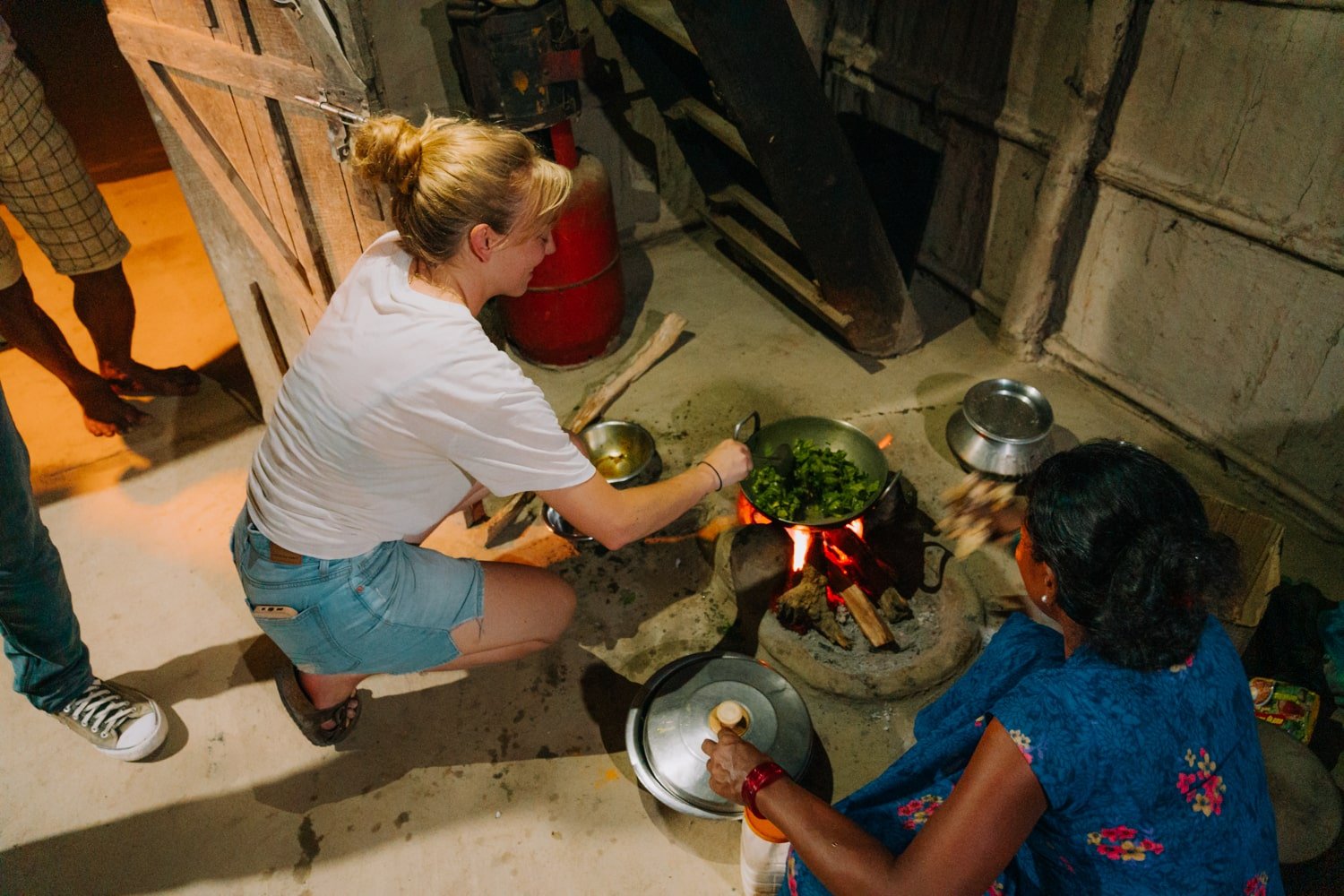
In the end, the experience of the Tharu homestay in Barauli, Chitwan is what made my trip down south worthwhile.
I definitely wouldn’t have had such a memorable time had I opted to stay in a resort/lodge in the touristy area of Sauraha in Chitwan.
Again, learning about and from the indigenous Tharu of the Nepalese Terai—the natives of the land we know as Chitwan National Park—was wonderfully eye-opening and is very important for understanding a sense of place.
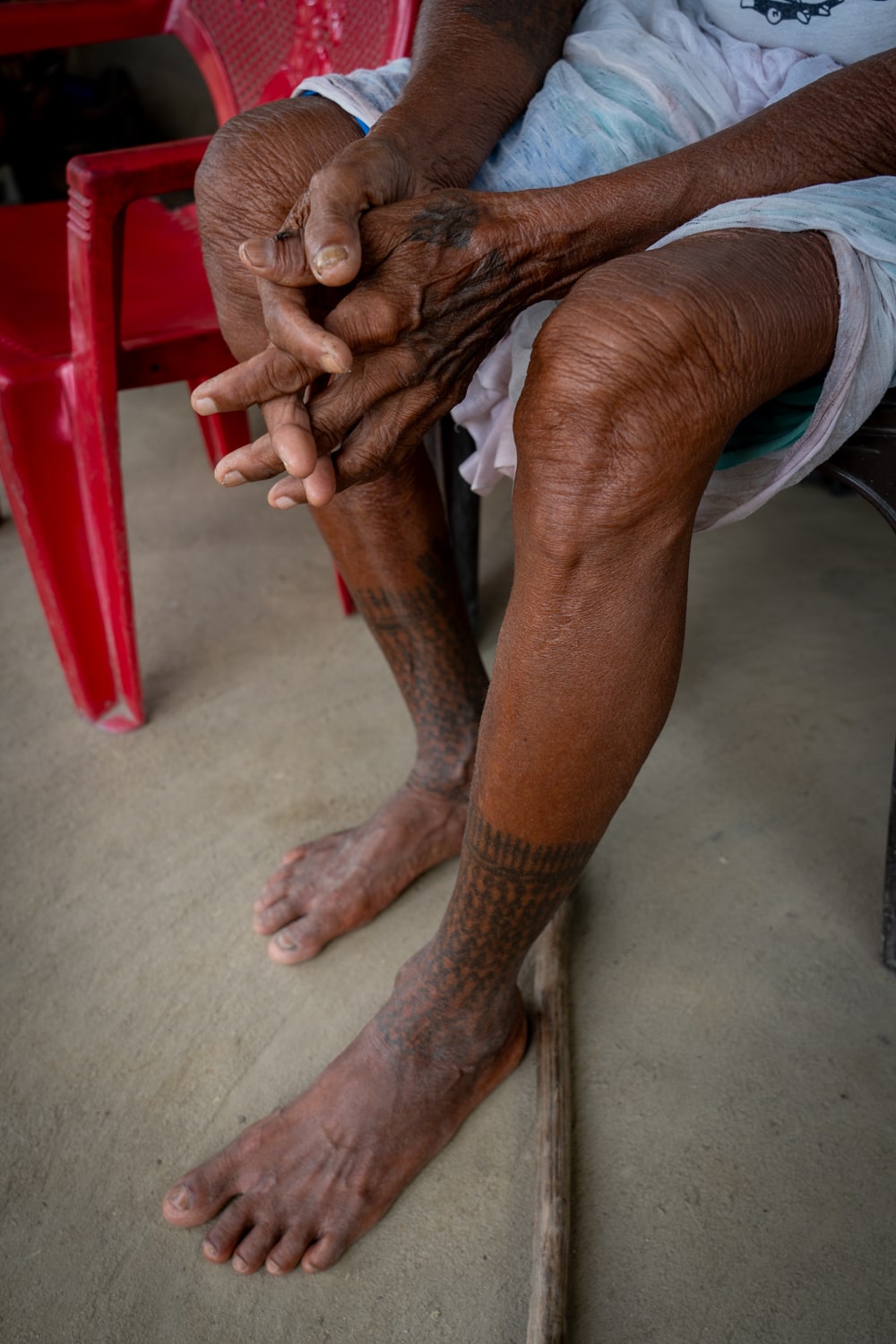
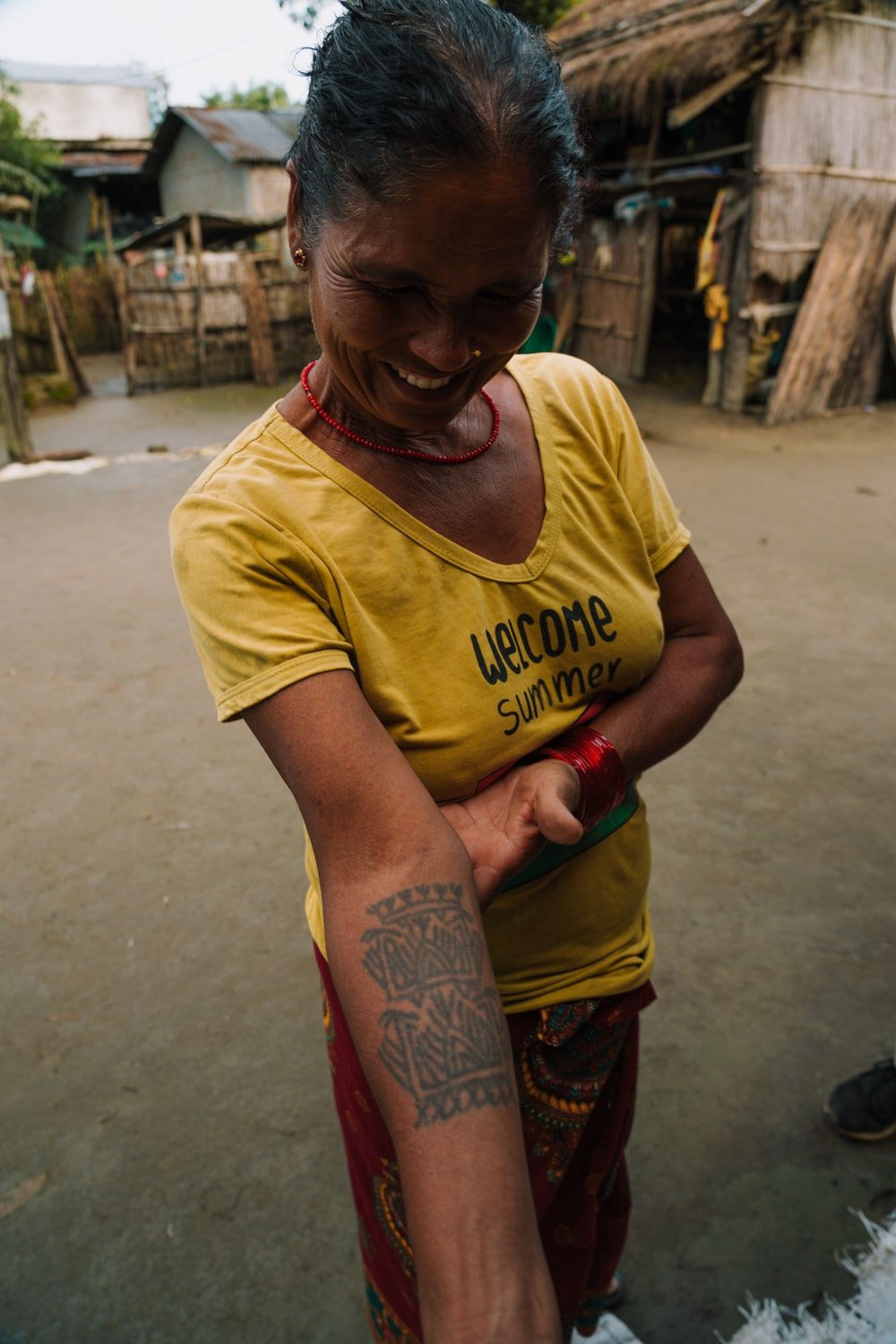
Moreover, I believe in the importance of supporting locals through community-based tourism.
This is important for everywhere you/I travel, but is especially important in remote areas such as Barauli (places that don’t often receive the benefits of tourism) which generates wealth for many local families.
When you can stay with the Tharu in Barauli and have a meaningful, impactful experience all around, why wouldn’t you?
That is the crux of why I’d definitely stay here again on a repeat trip to Chitwan, and would happily do more homestays in Nepal with CHN.
If you have any questions about by Tharu/Barauli Homestay experience, please let me know in the comments below!
Note: I was hosted by the Tharu/Barauli Homestay in partnership with the Community Homestay Network to raise awareness of responsible community tourism in Nepal. All opinions/statements of this article are my own and, as always, are not influenced by the partnership.
<!–
–>



